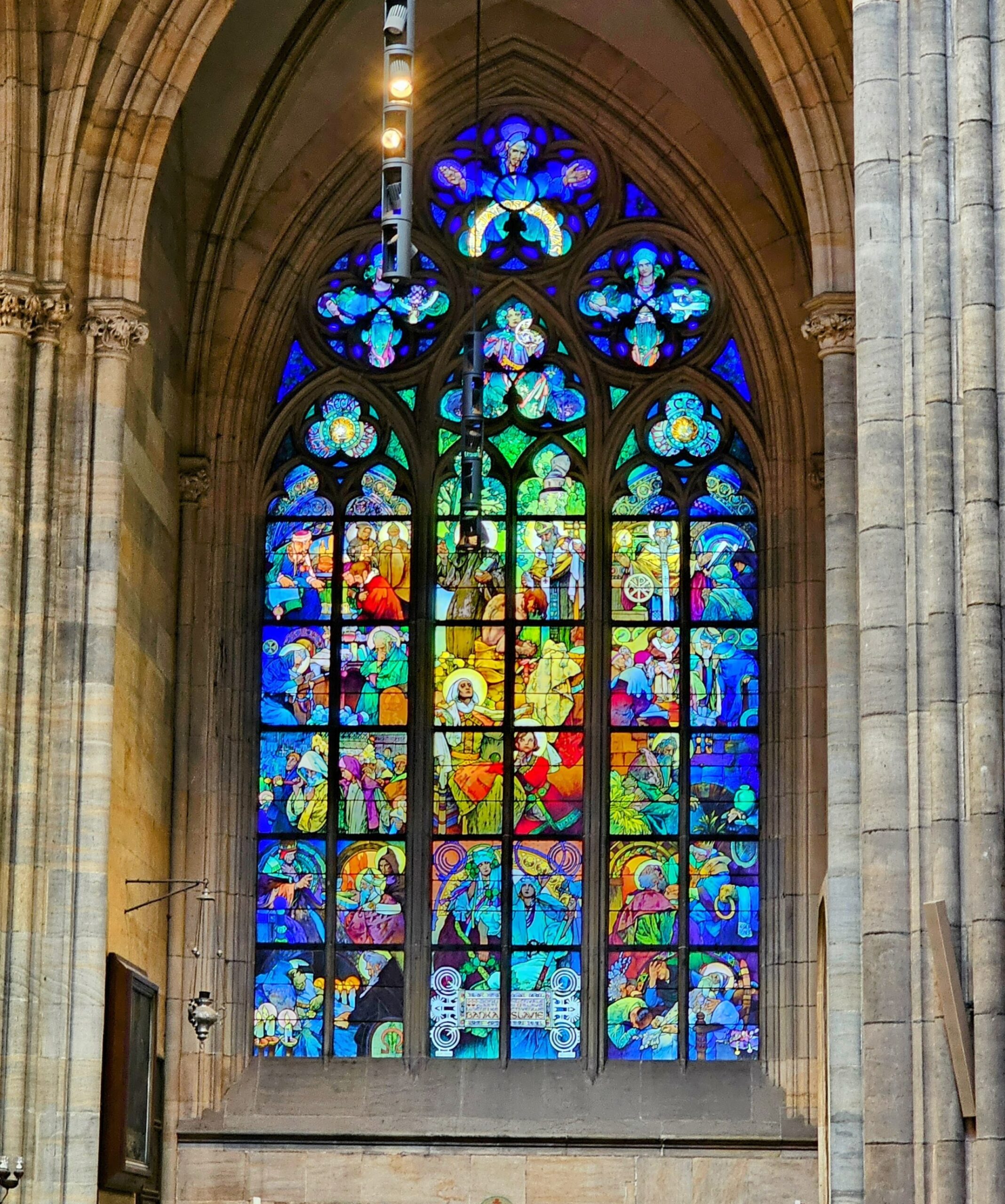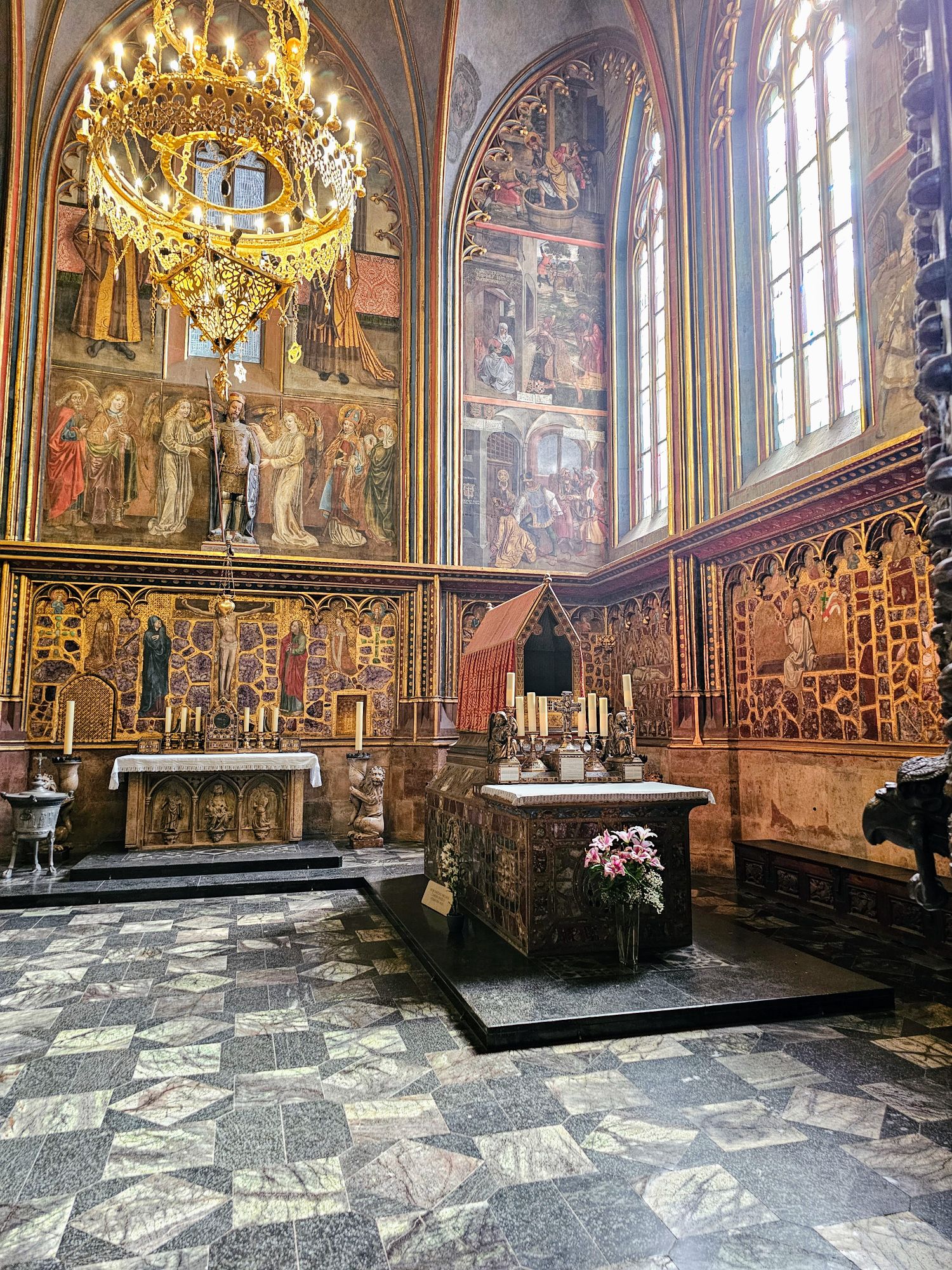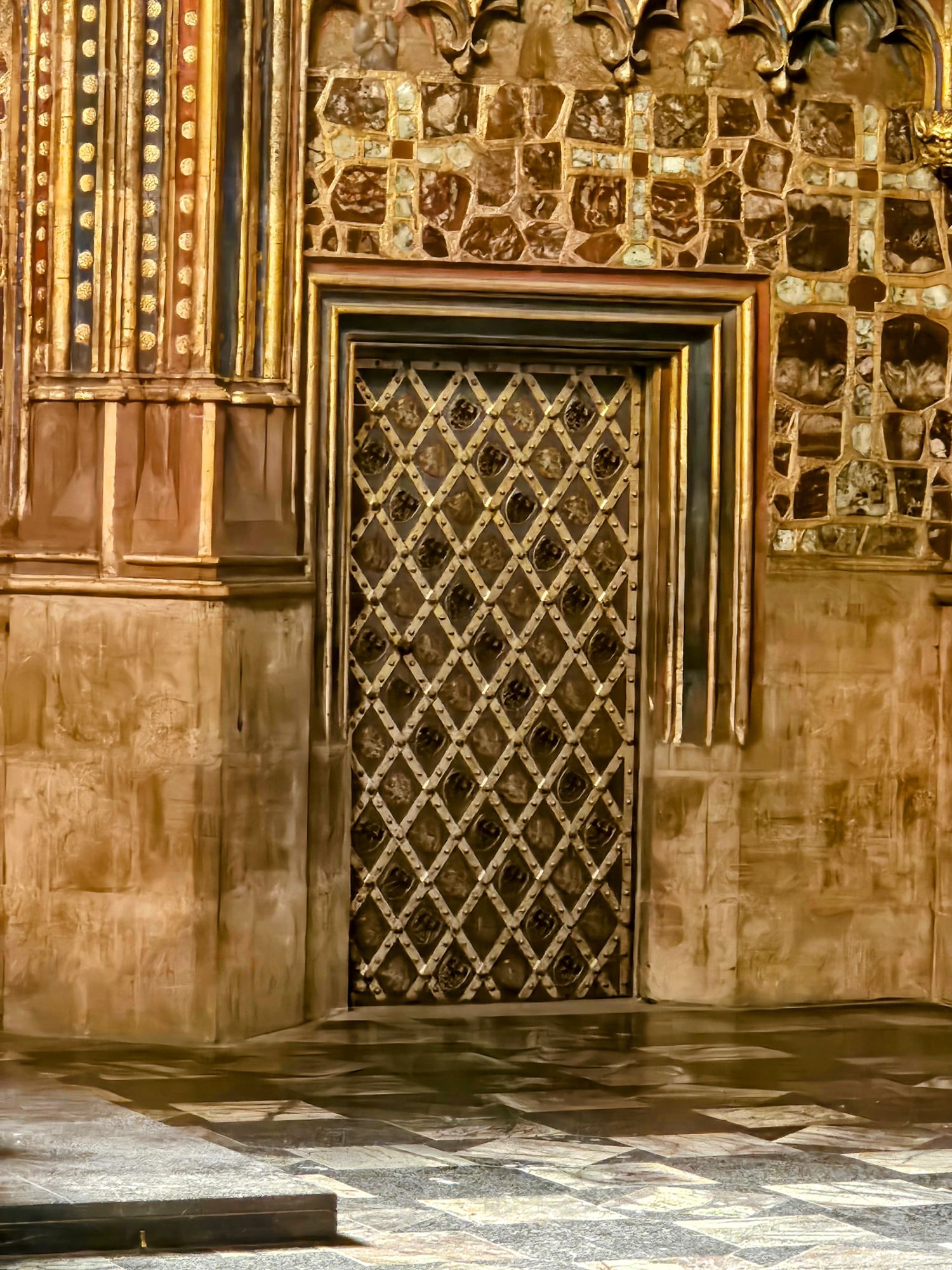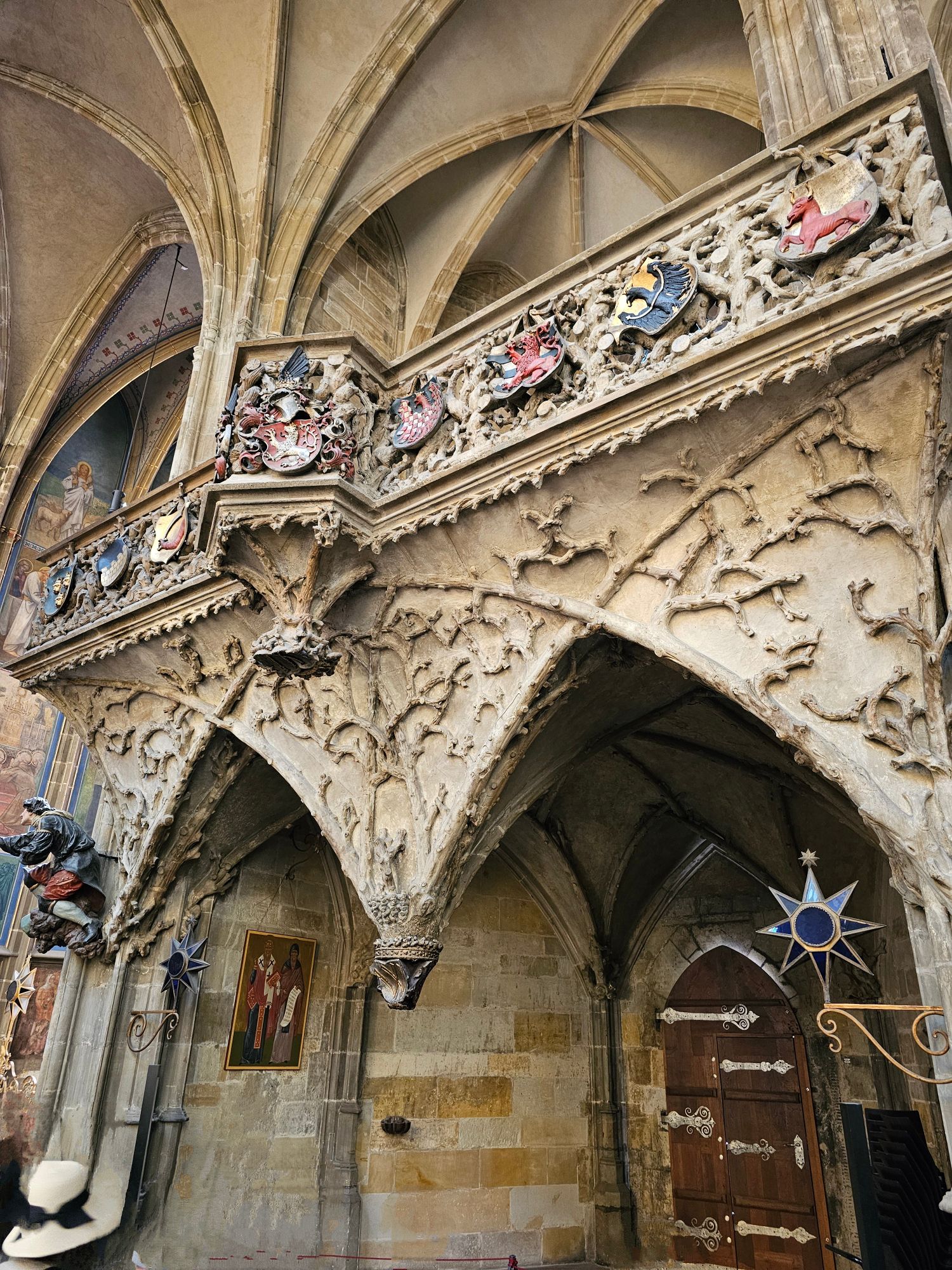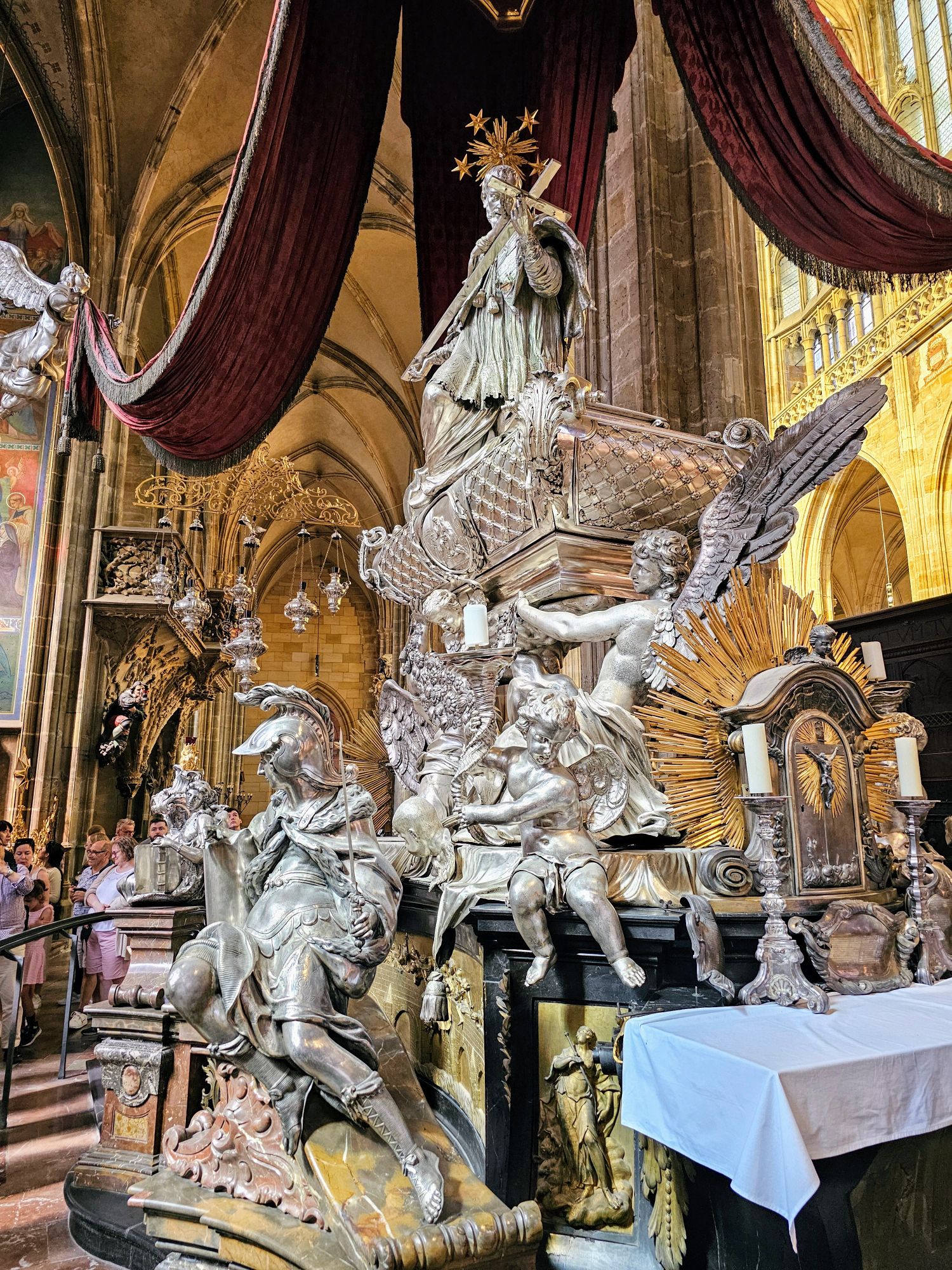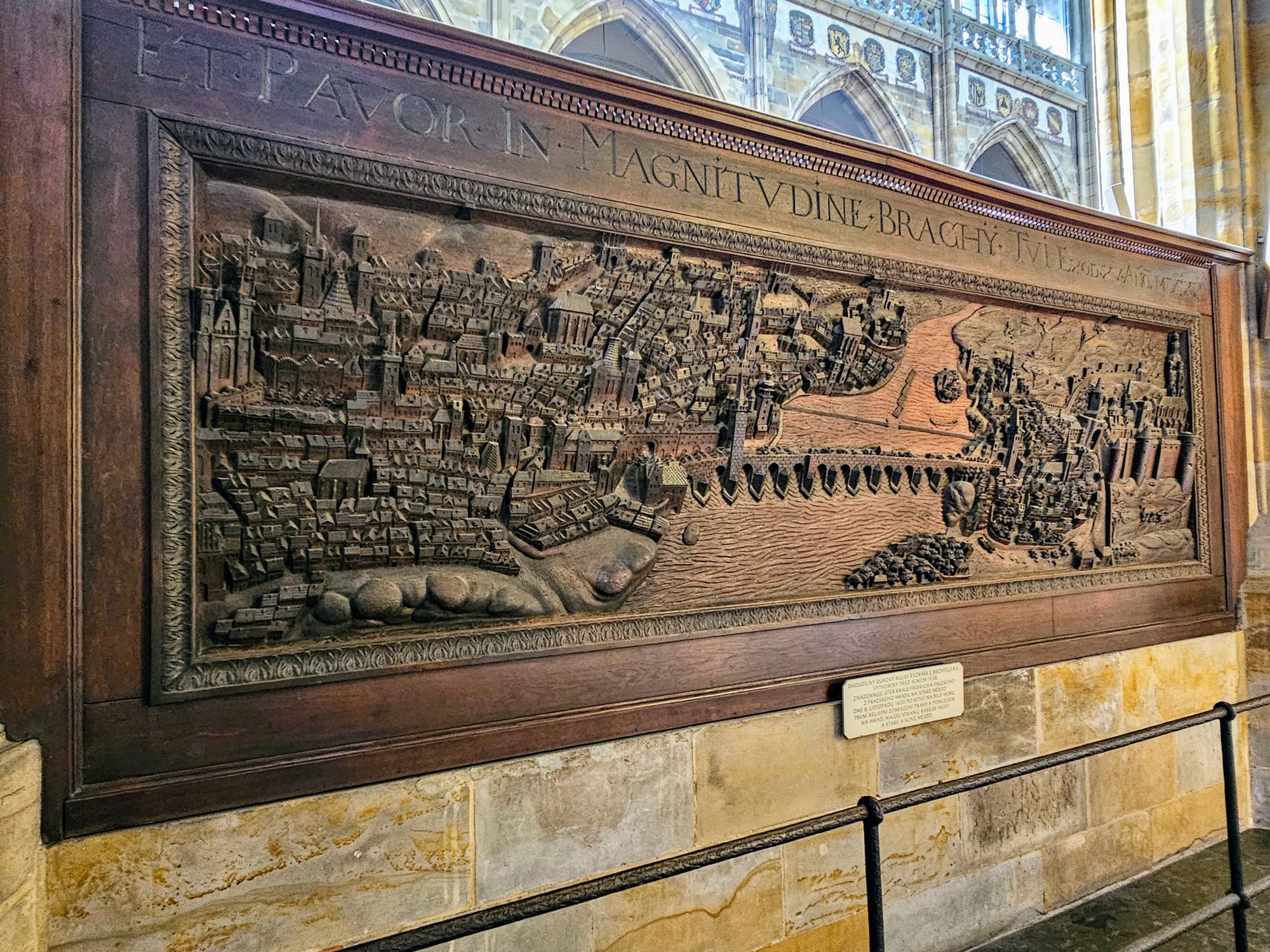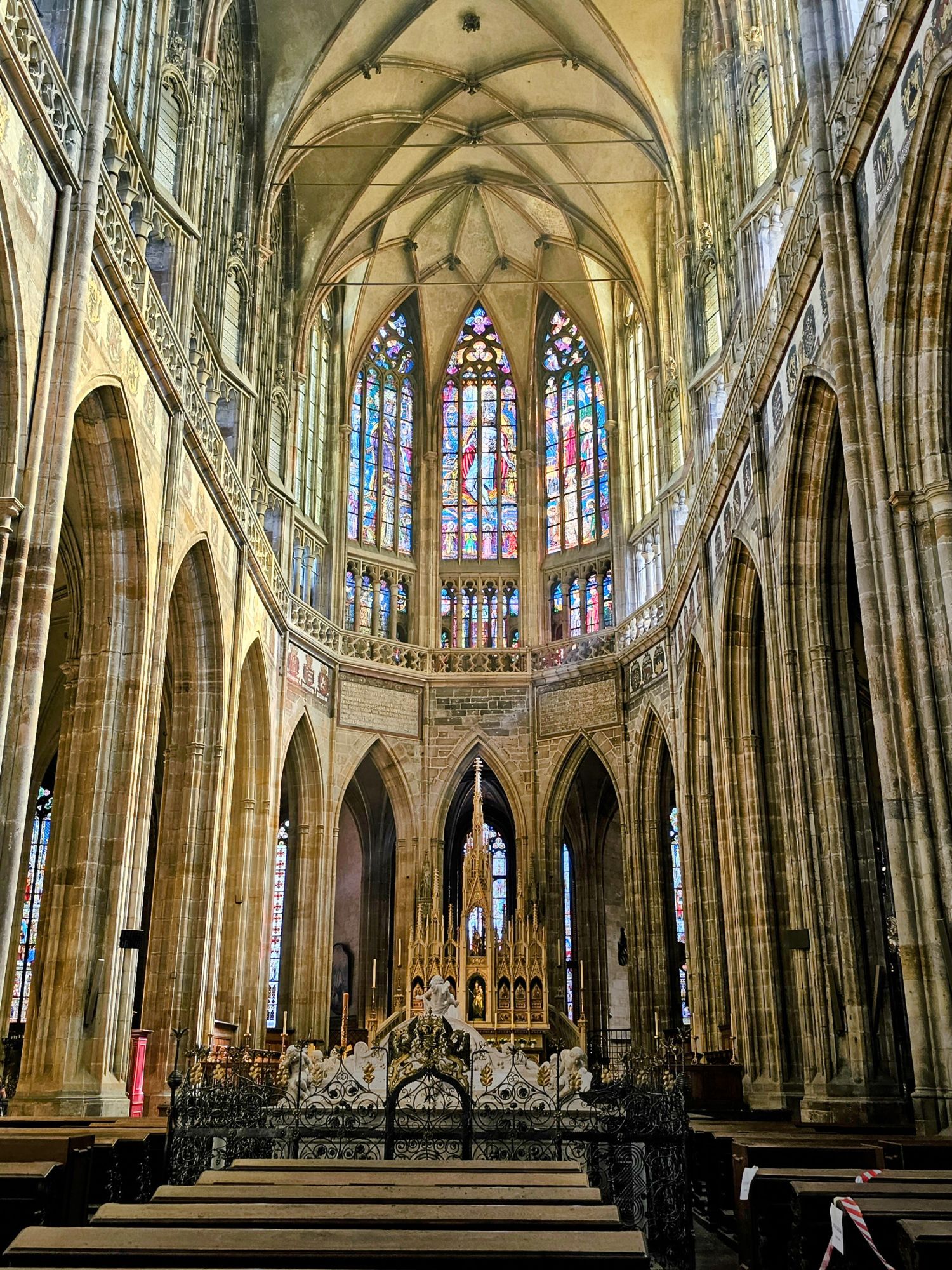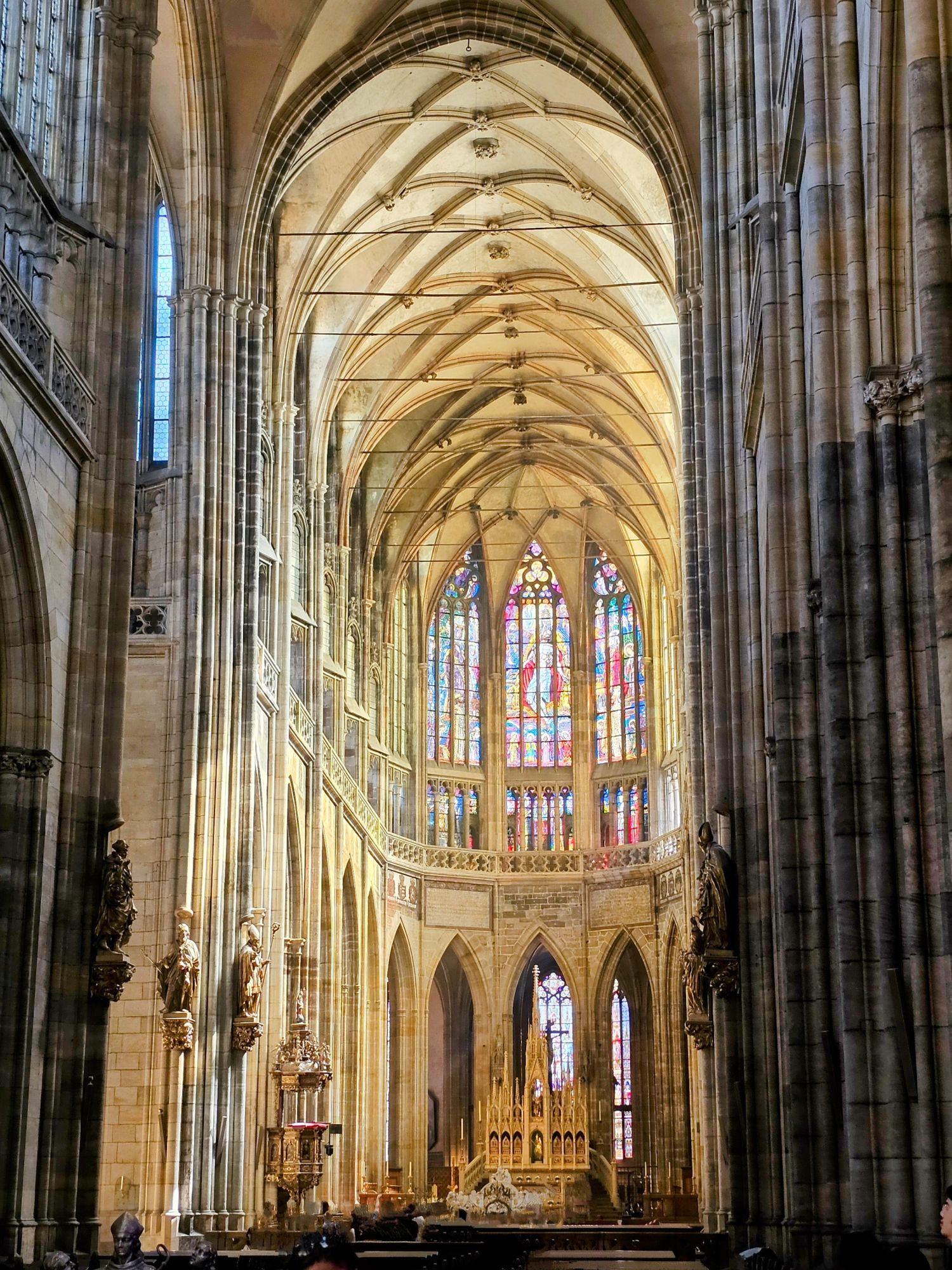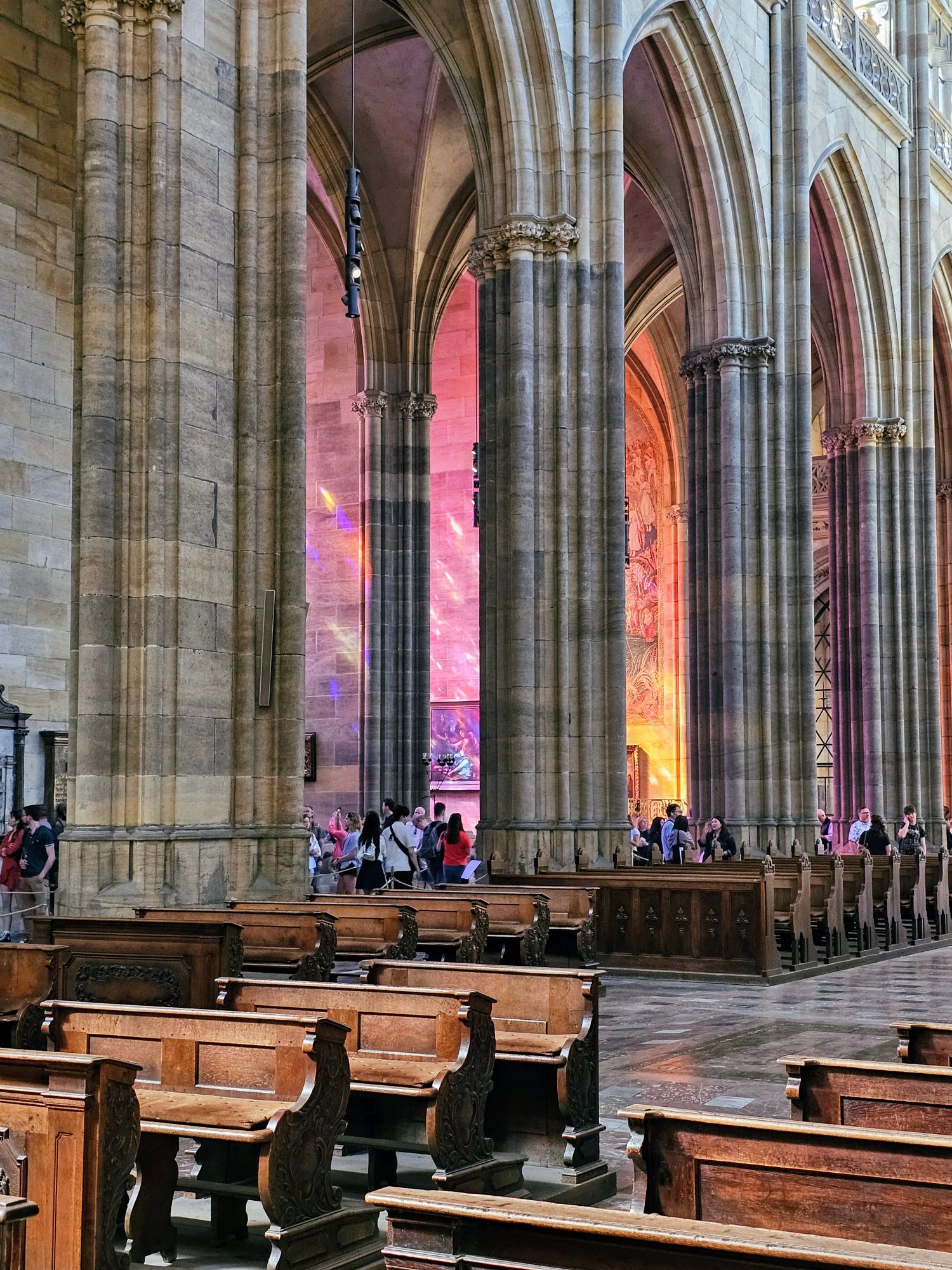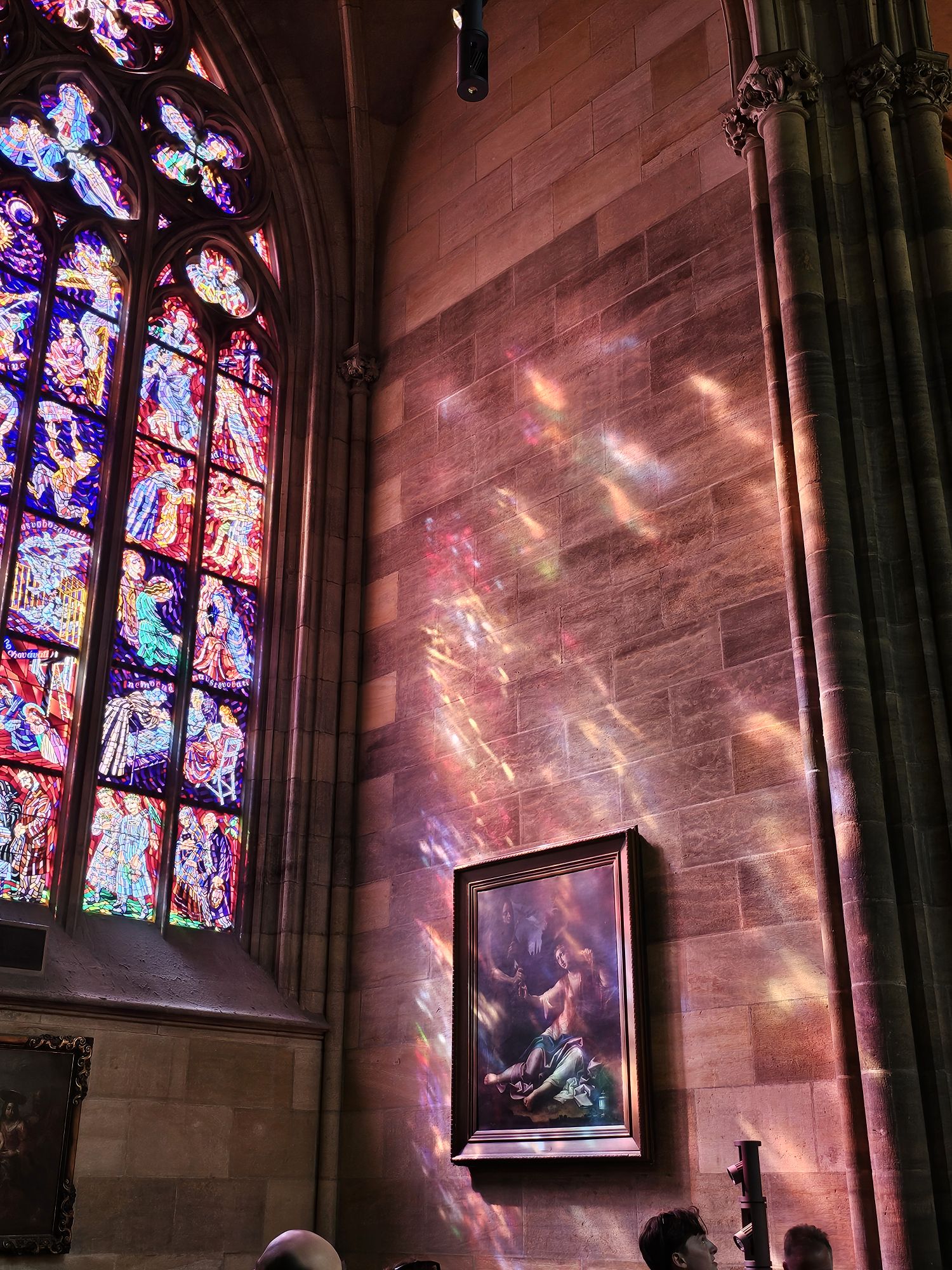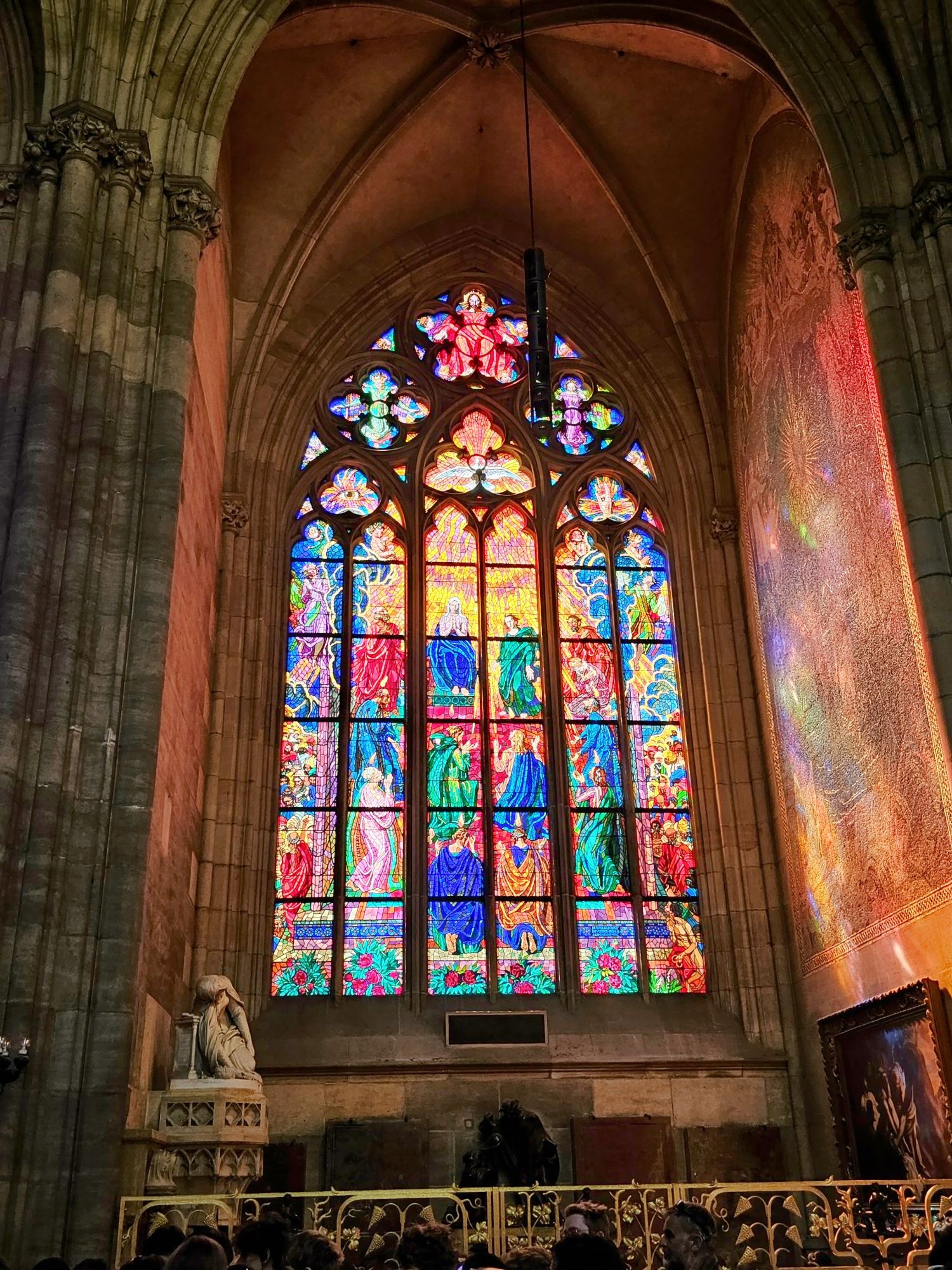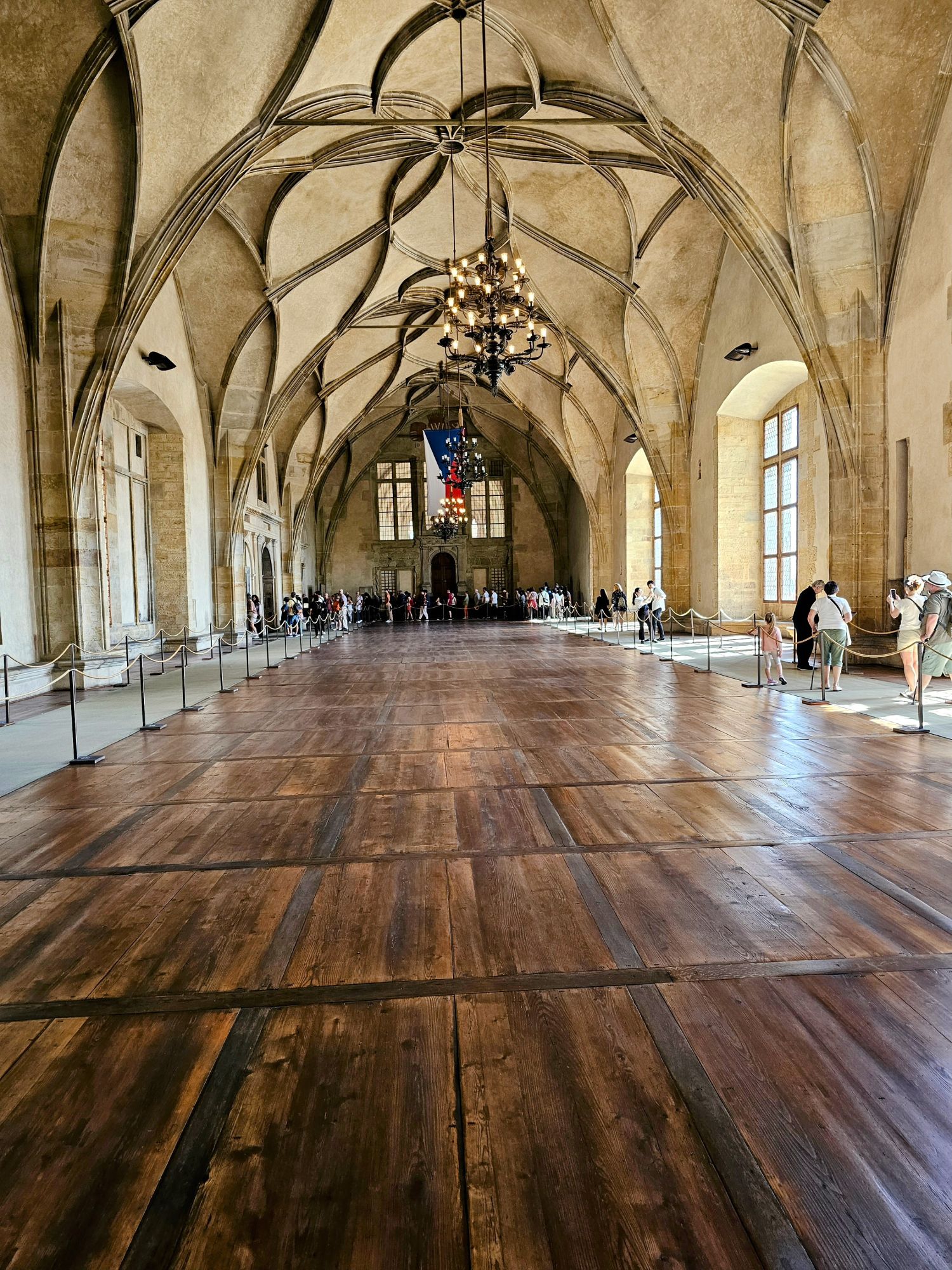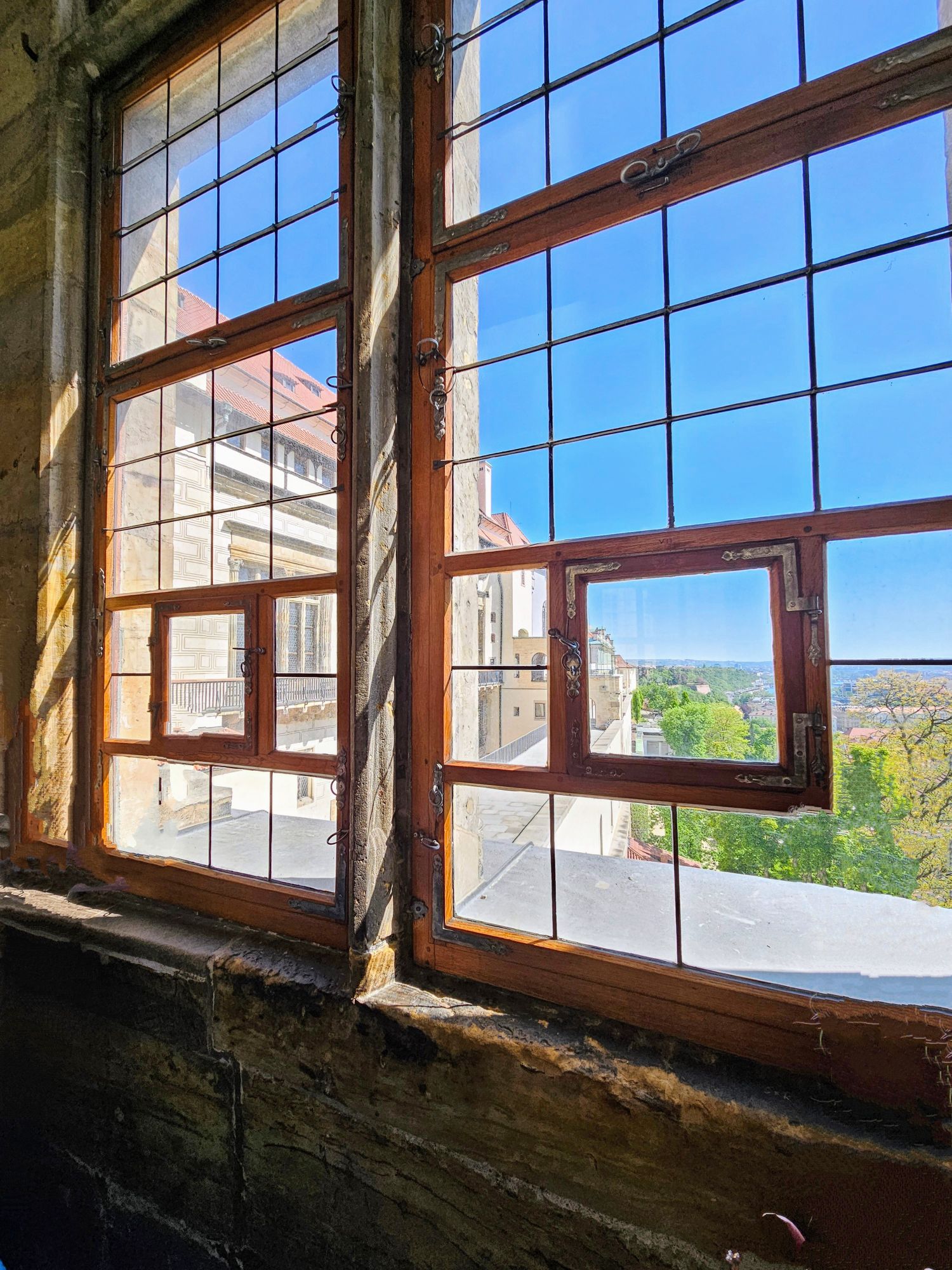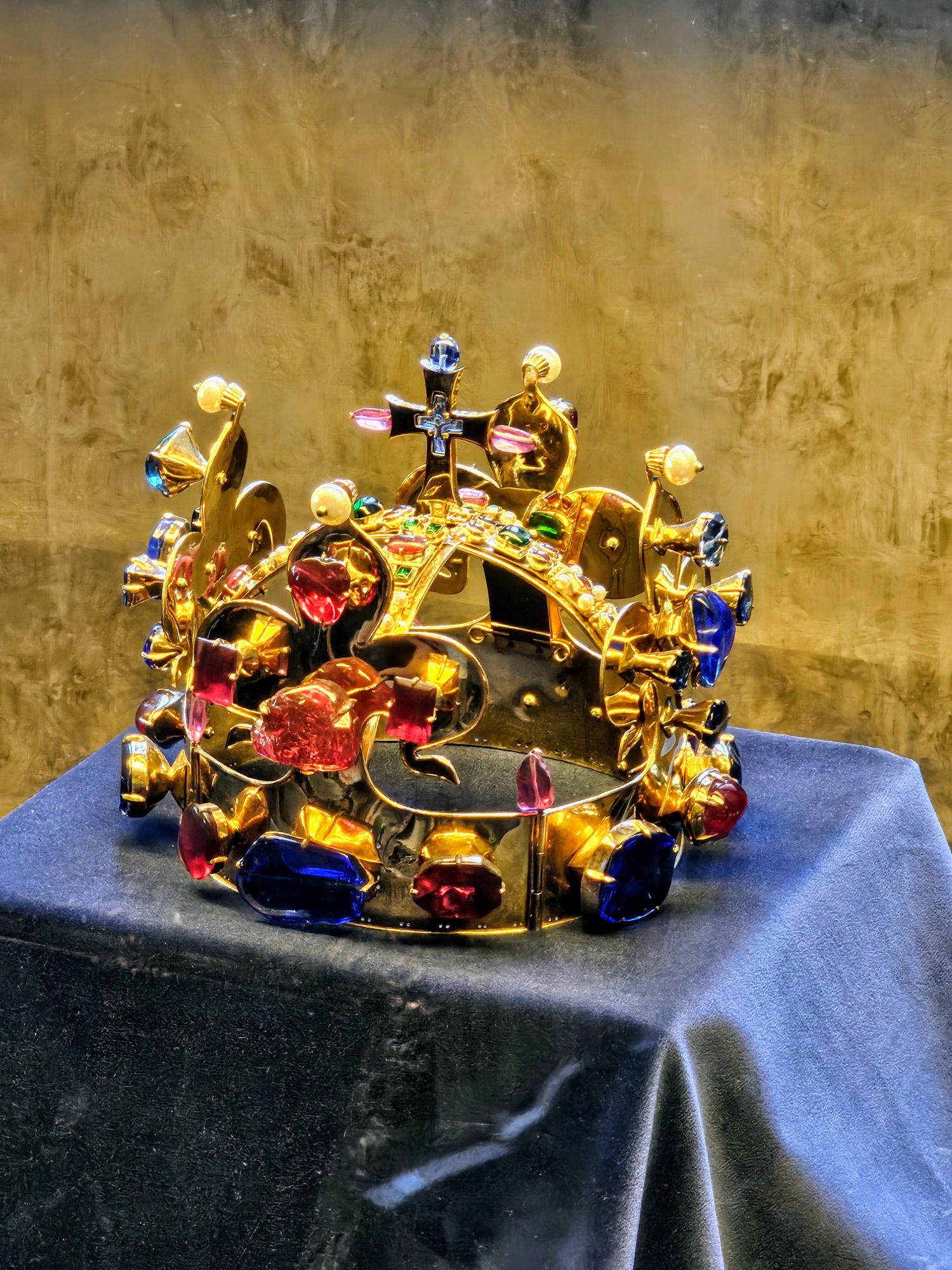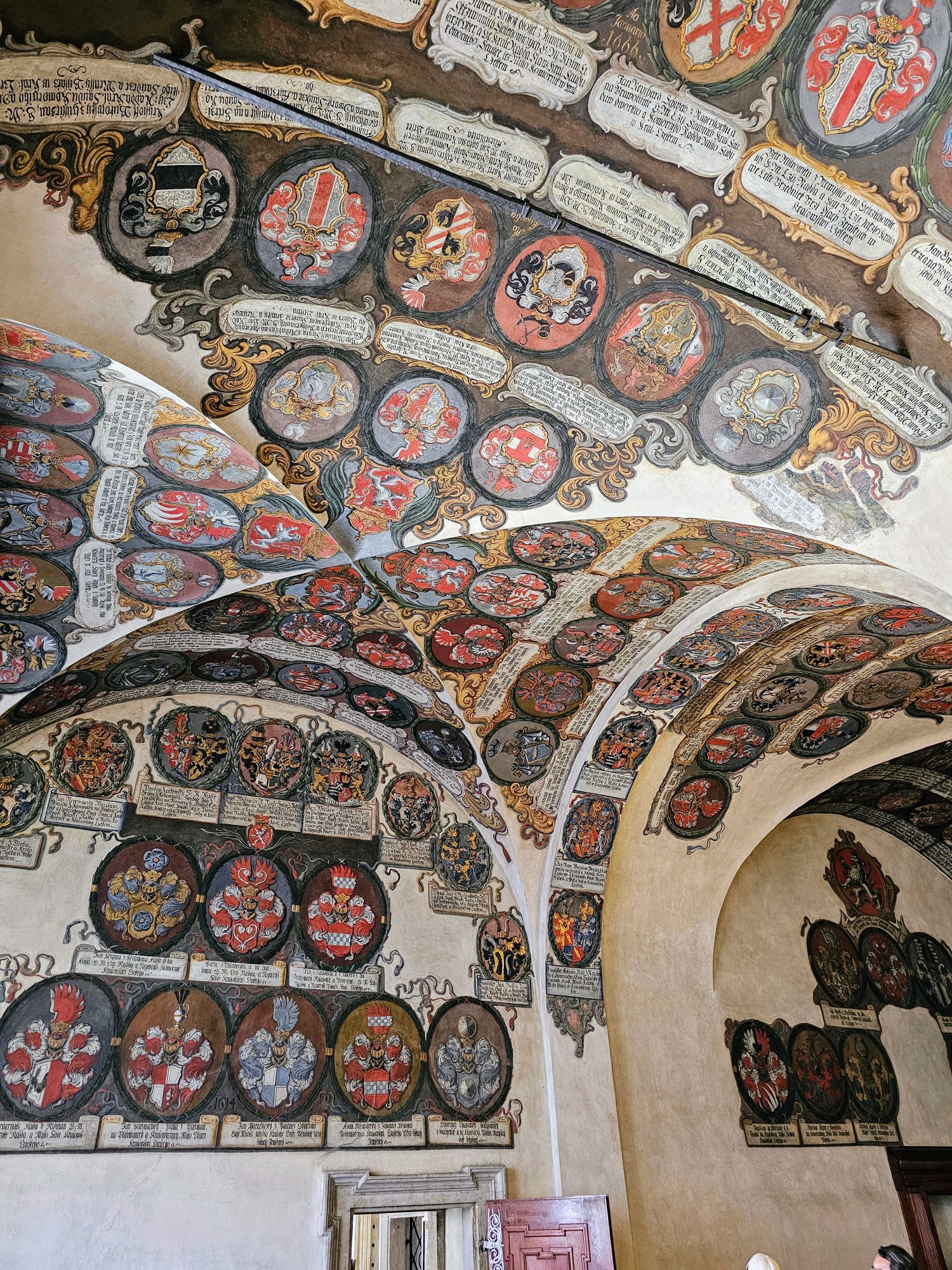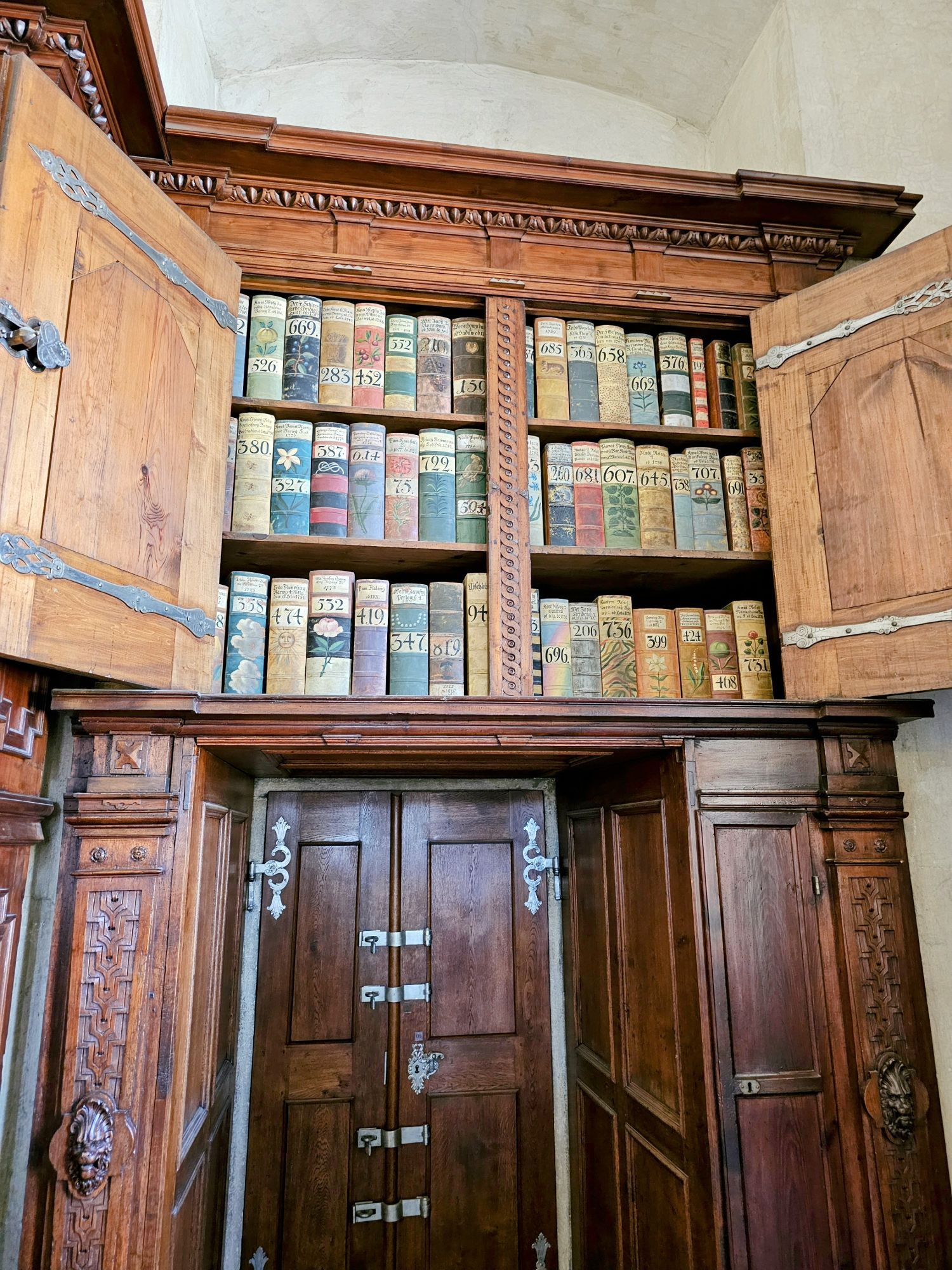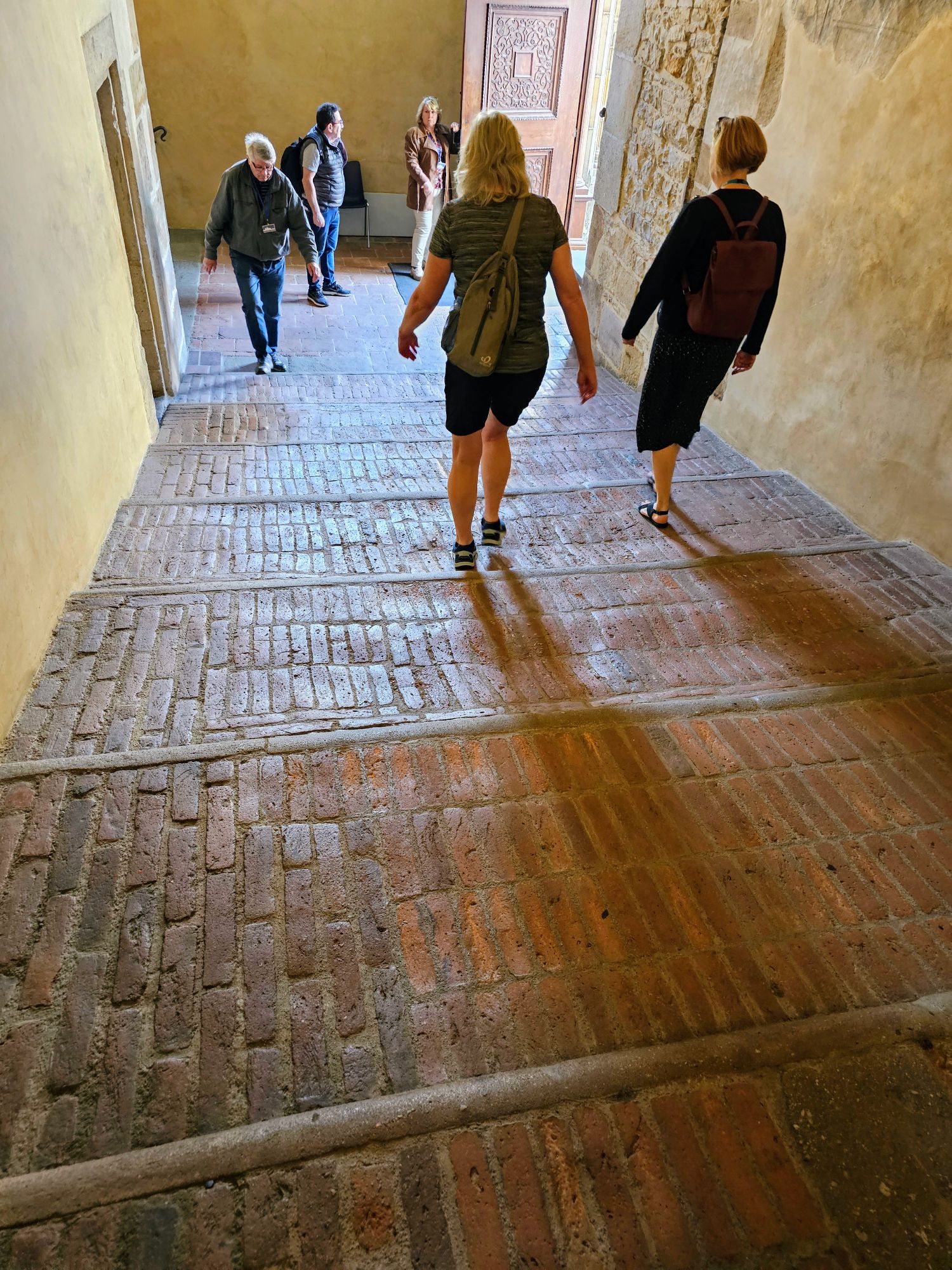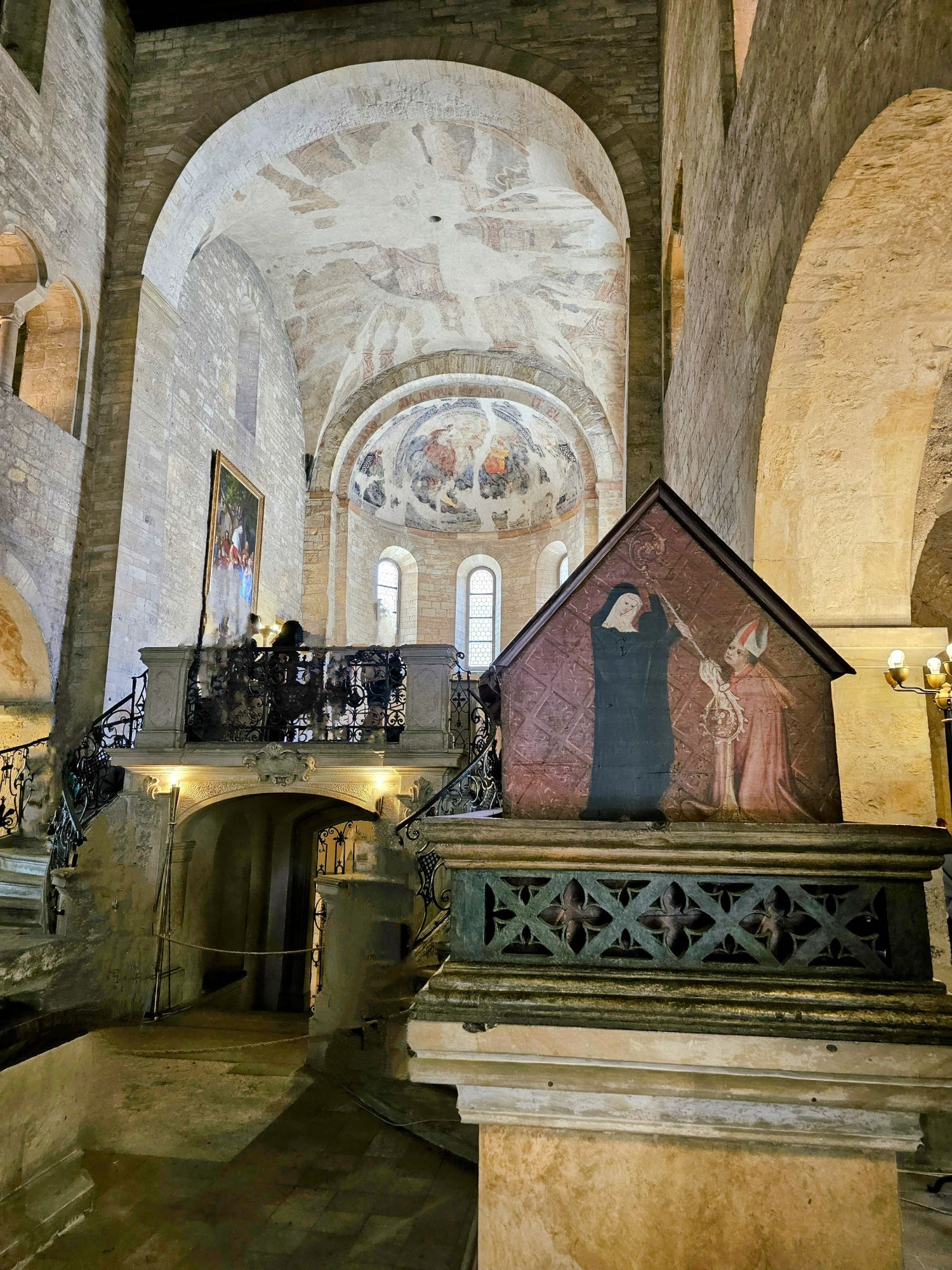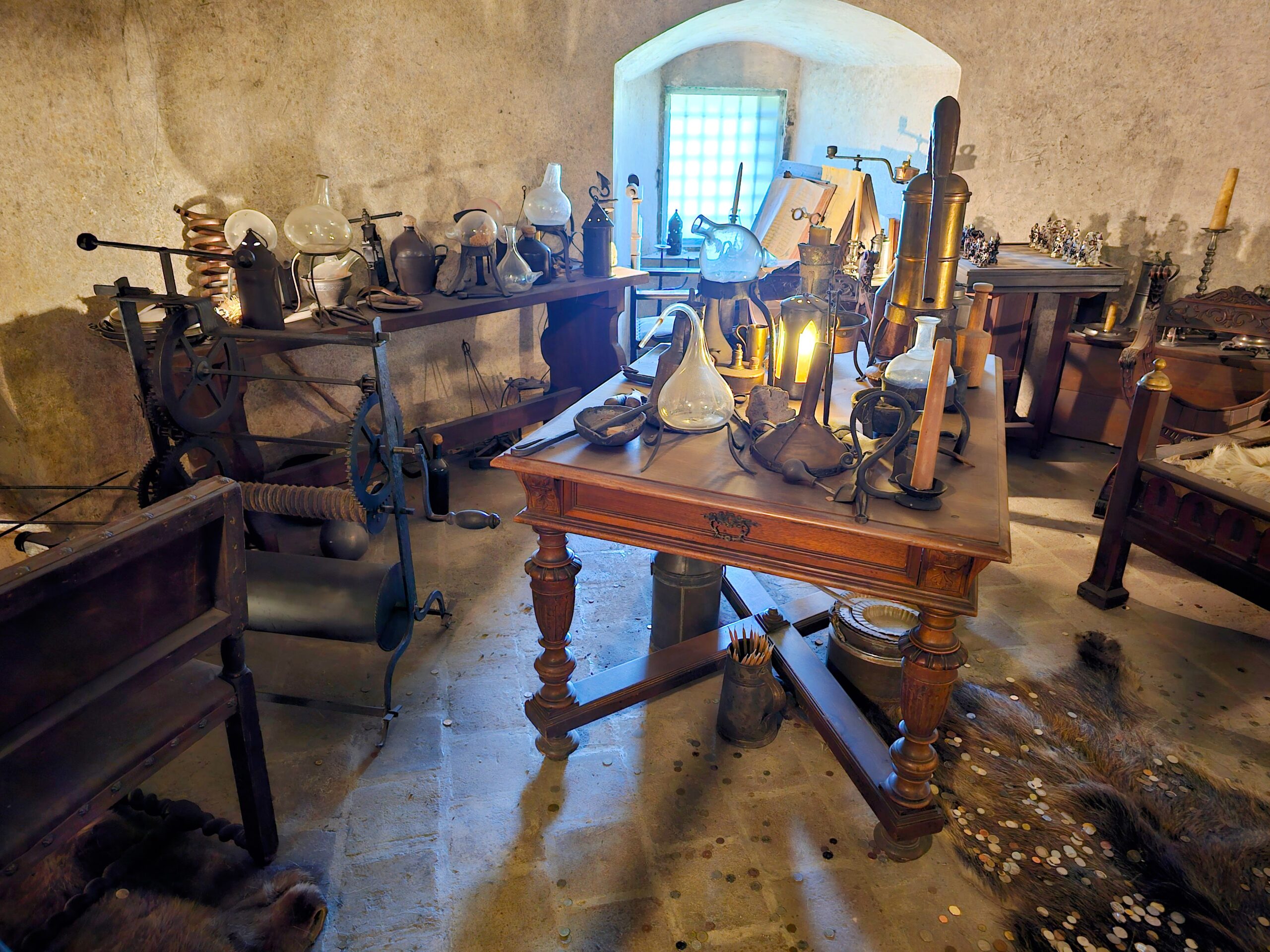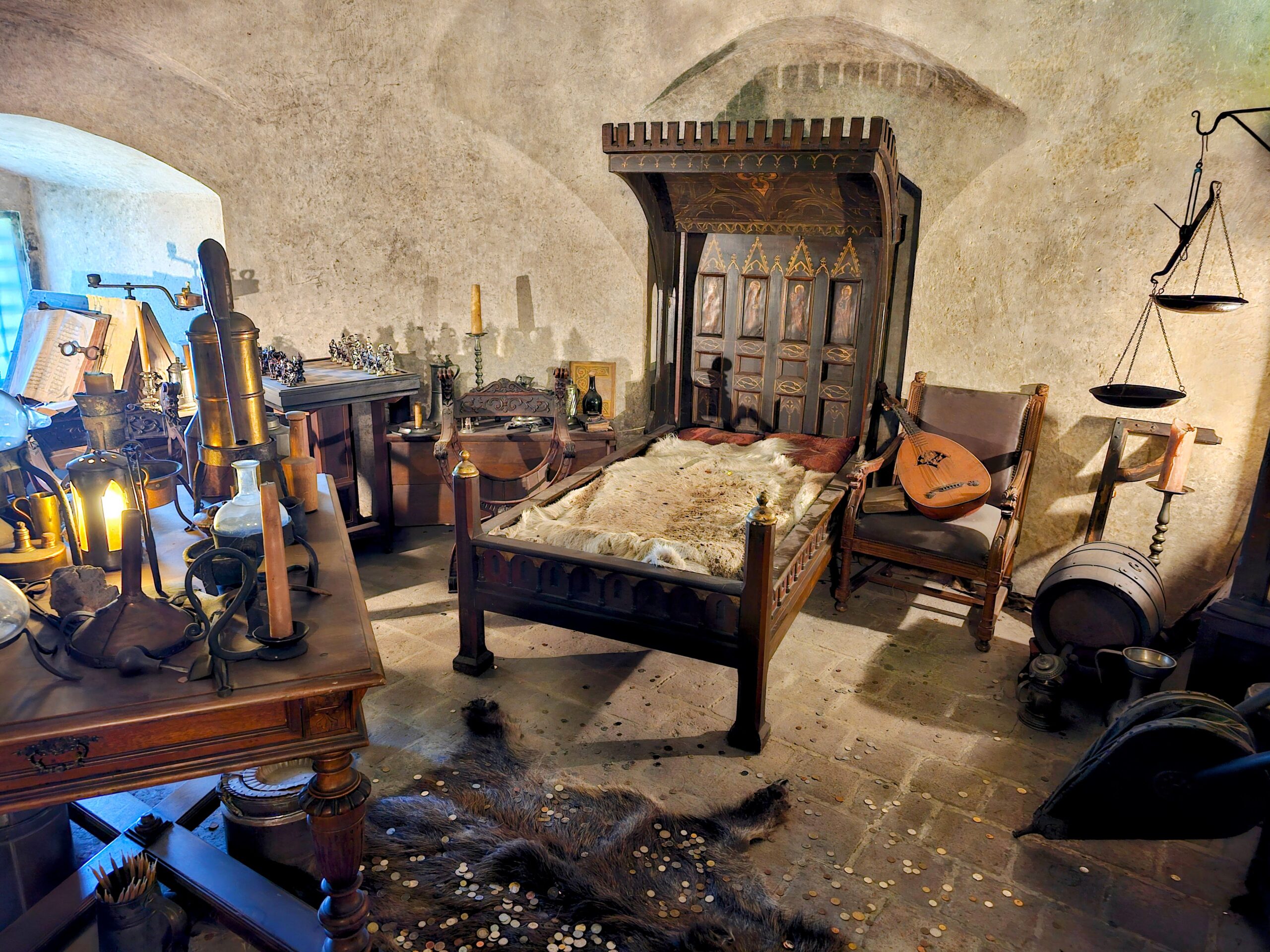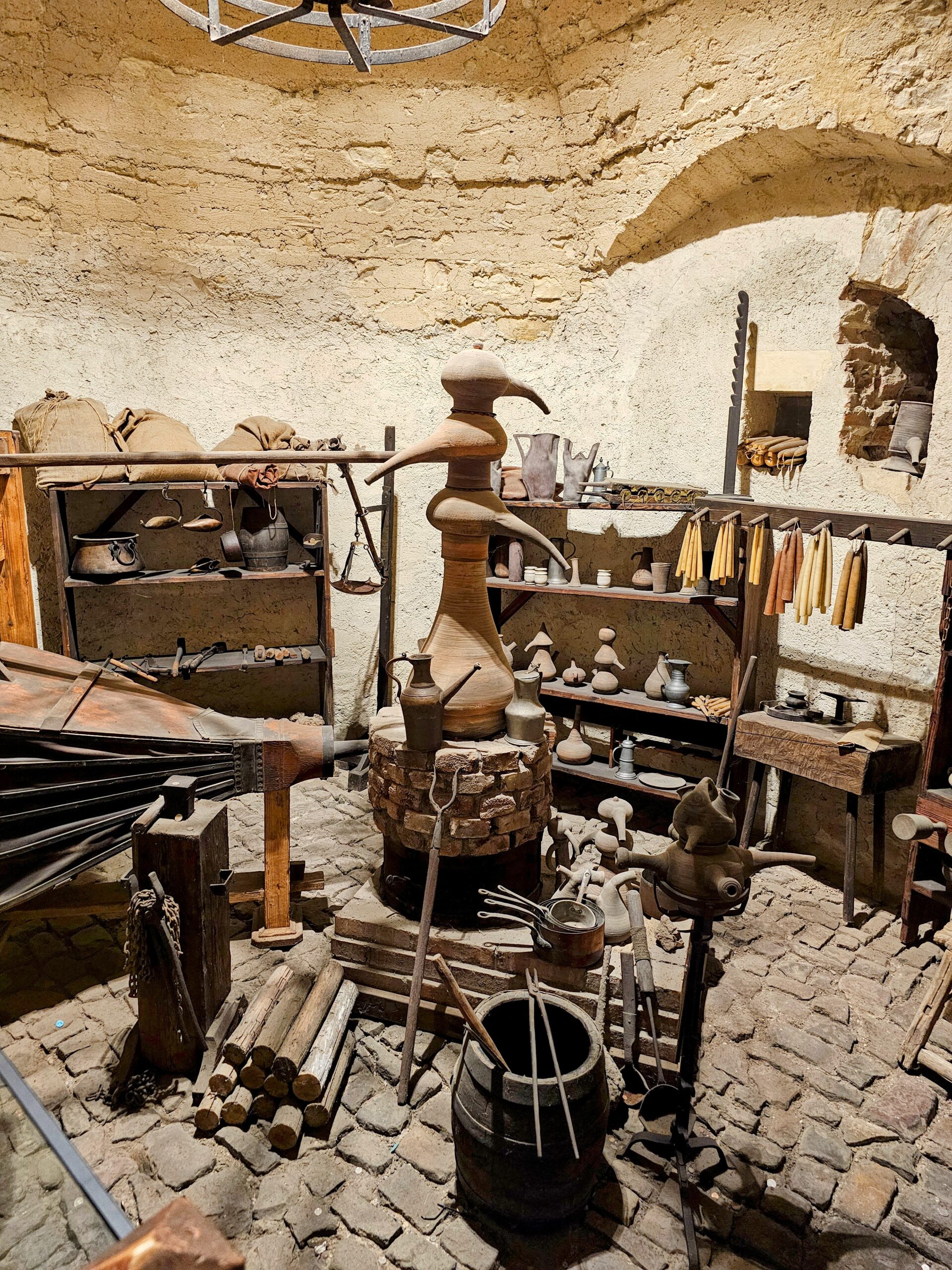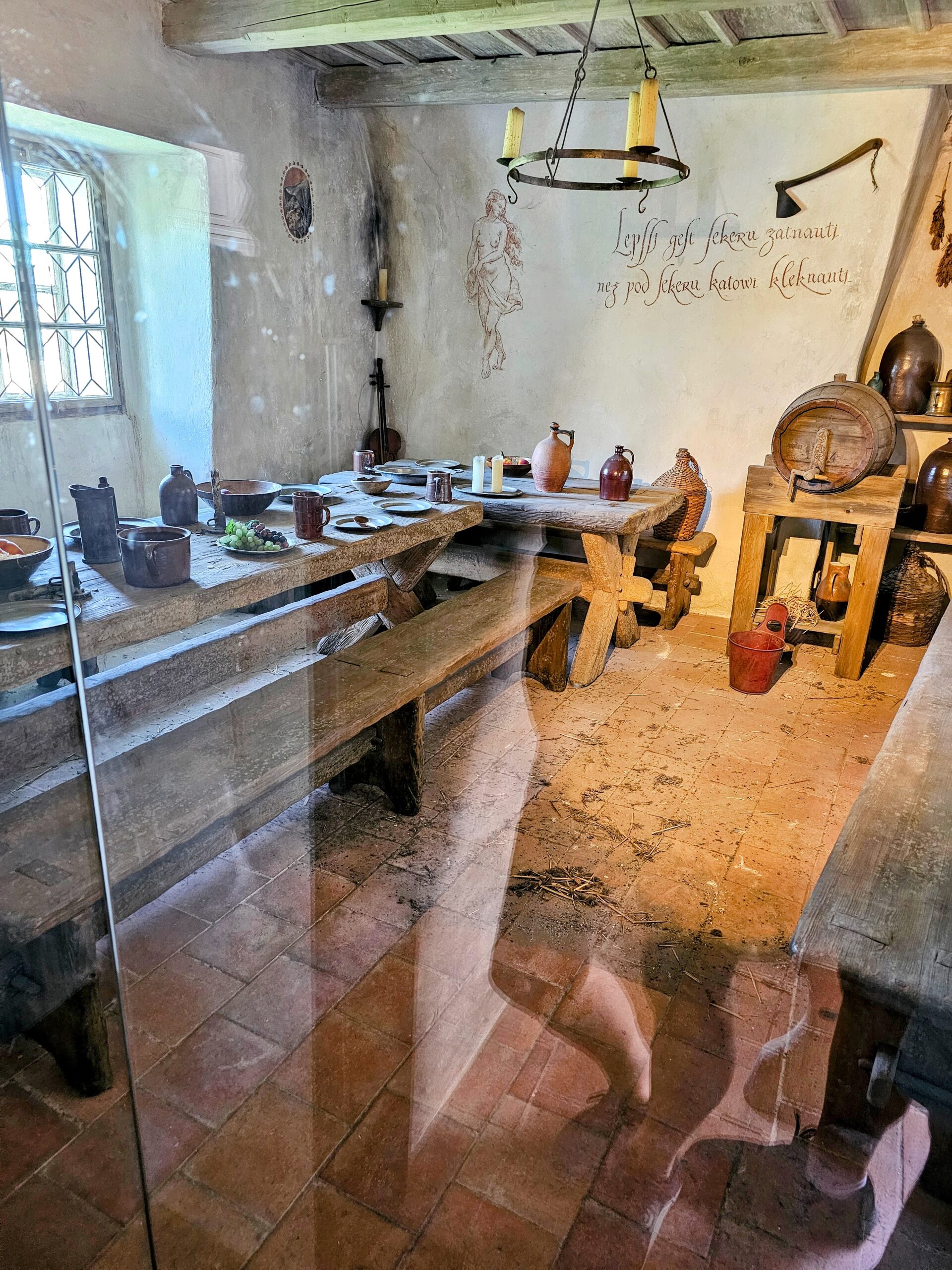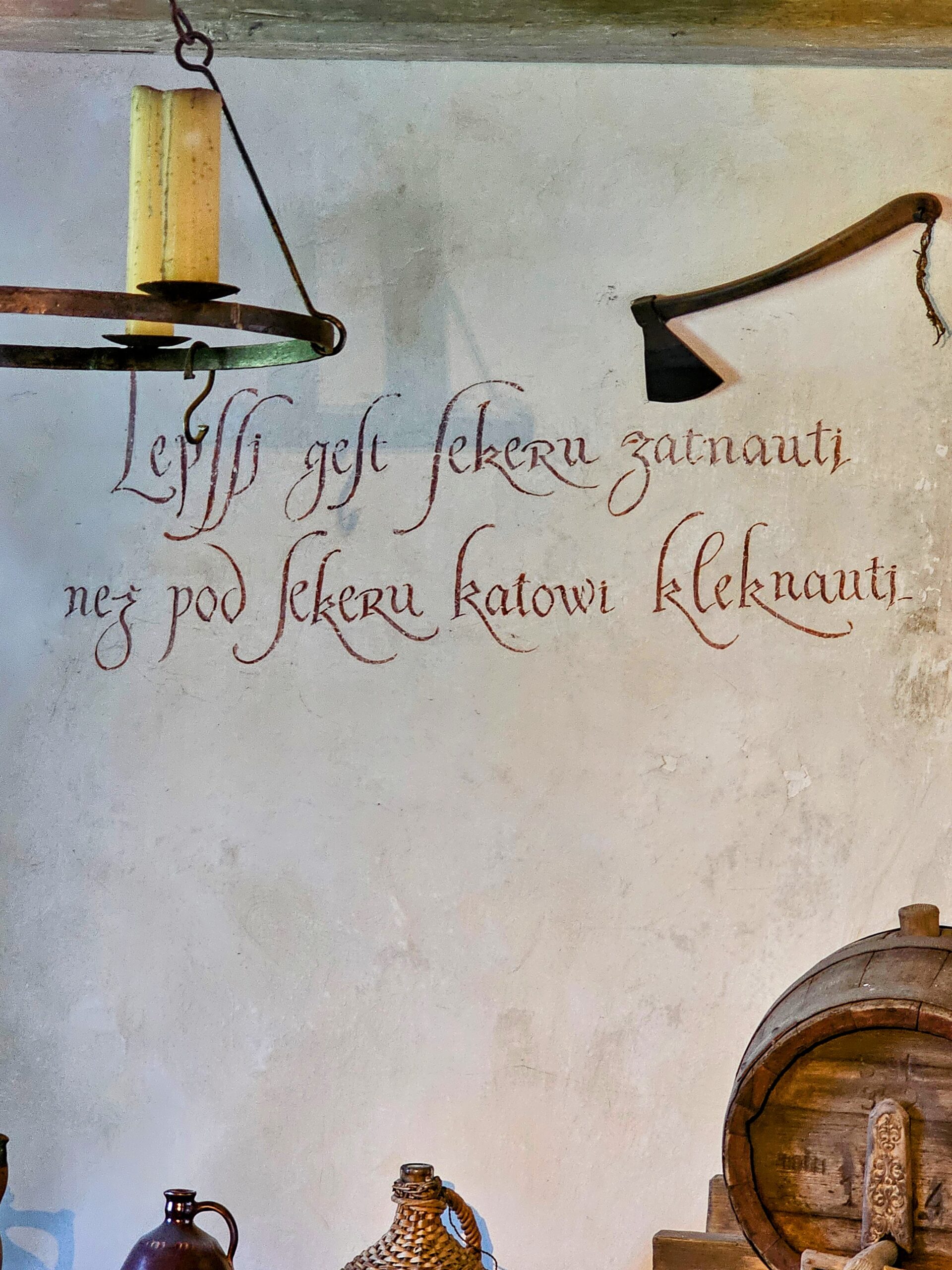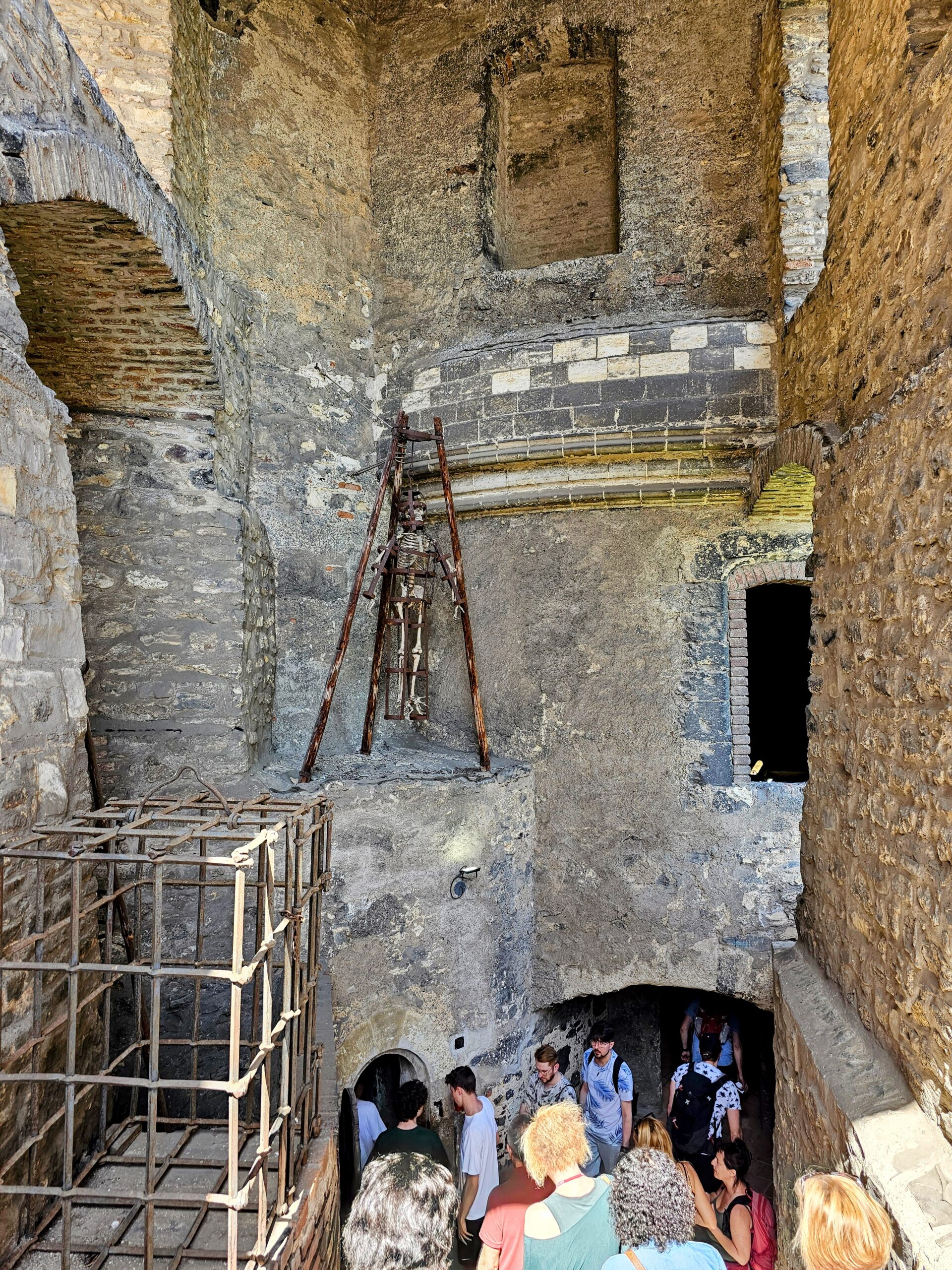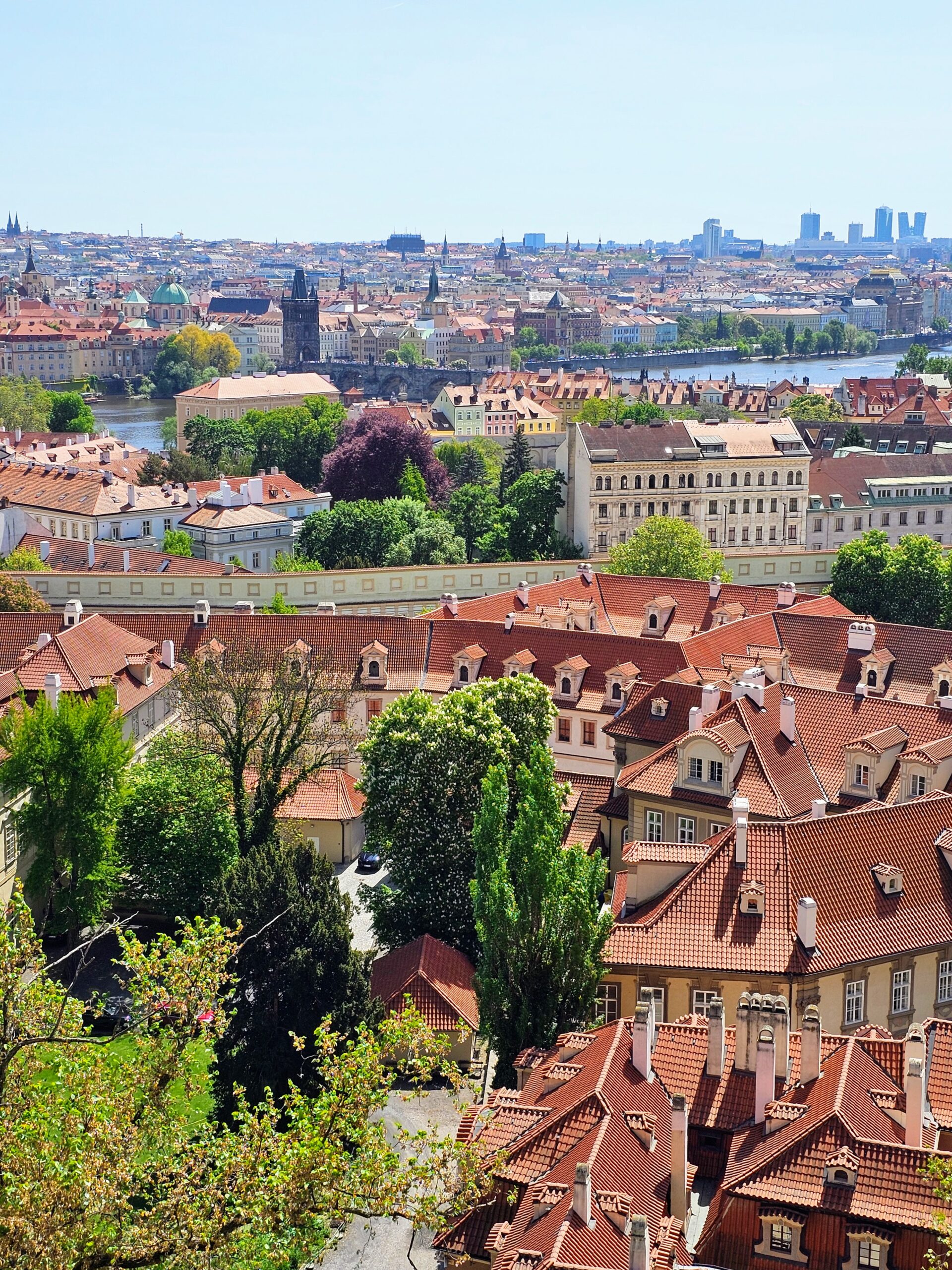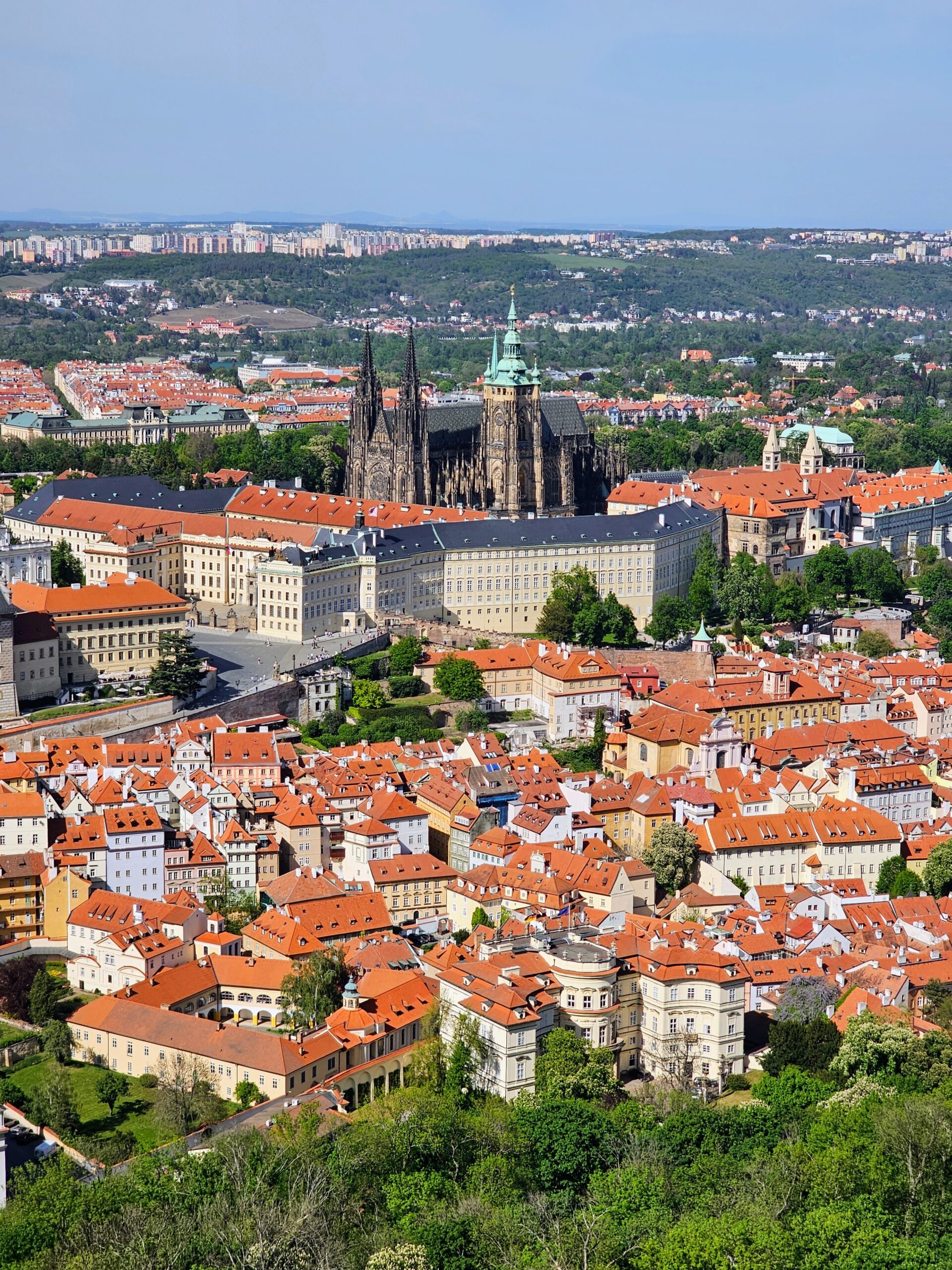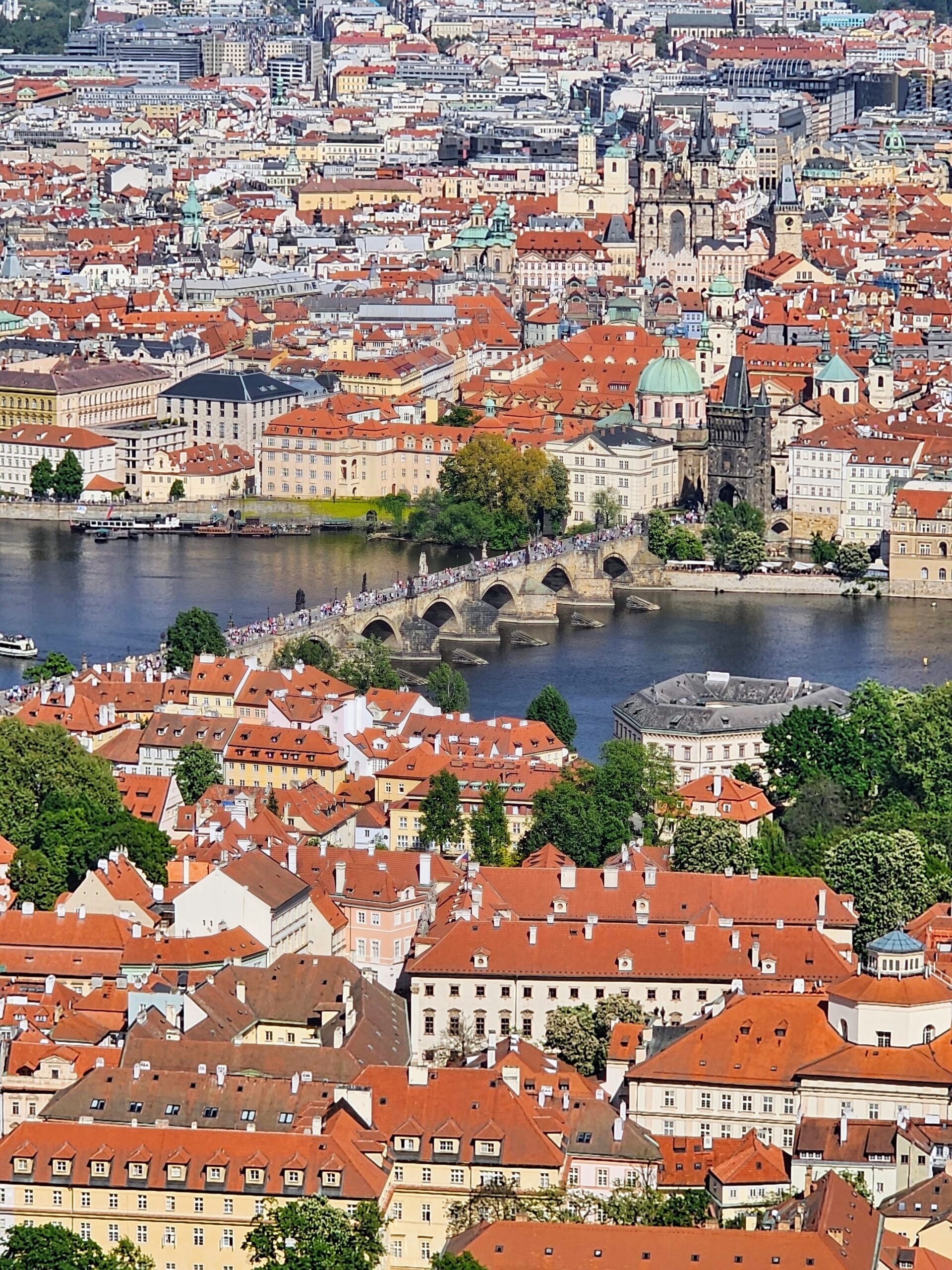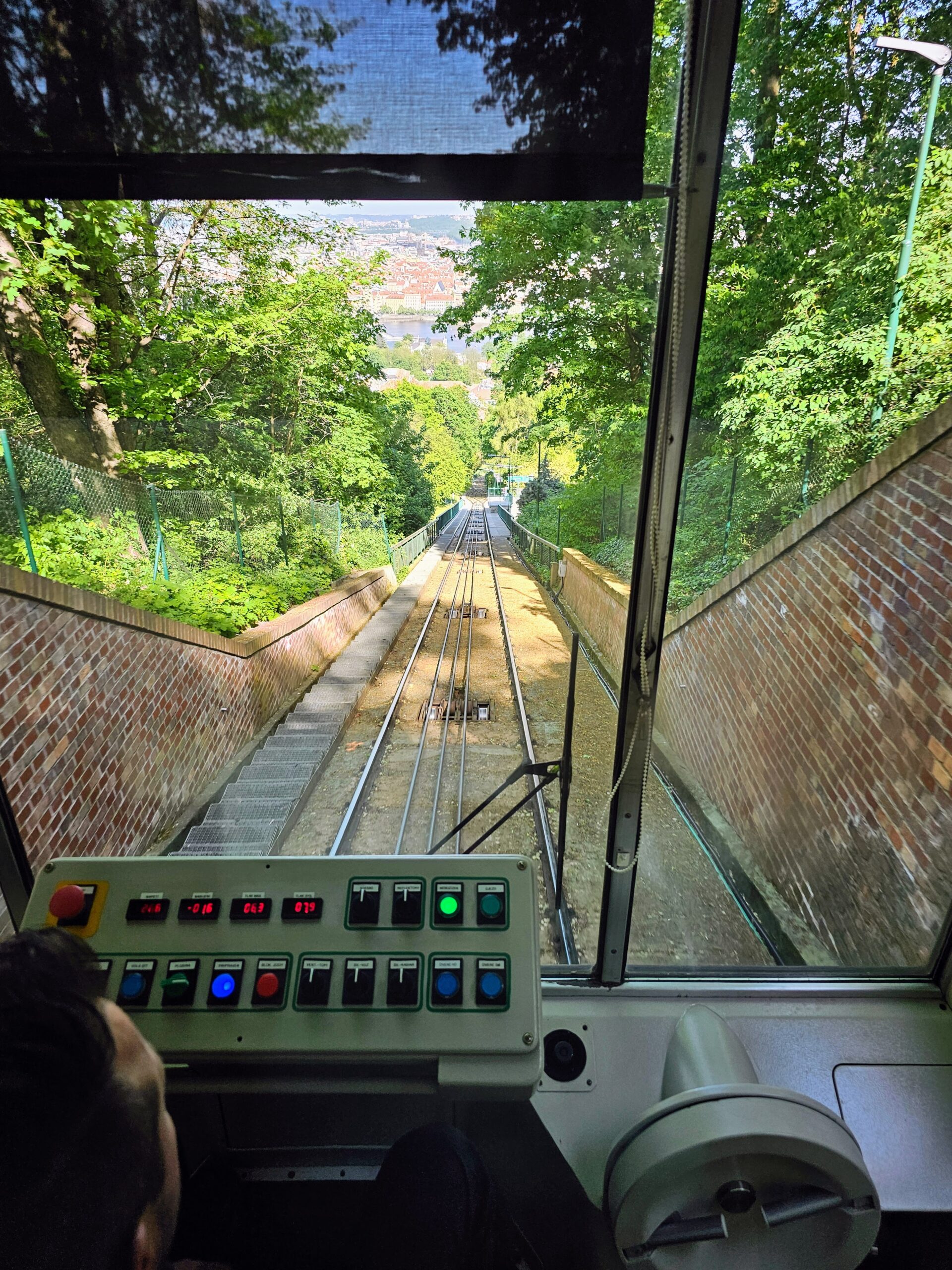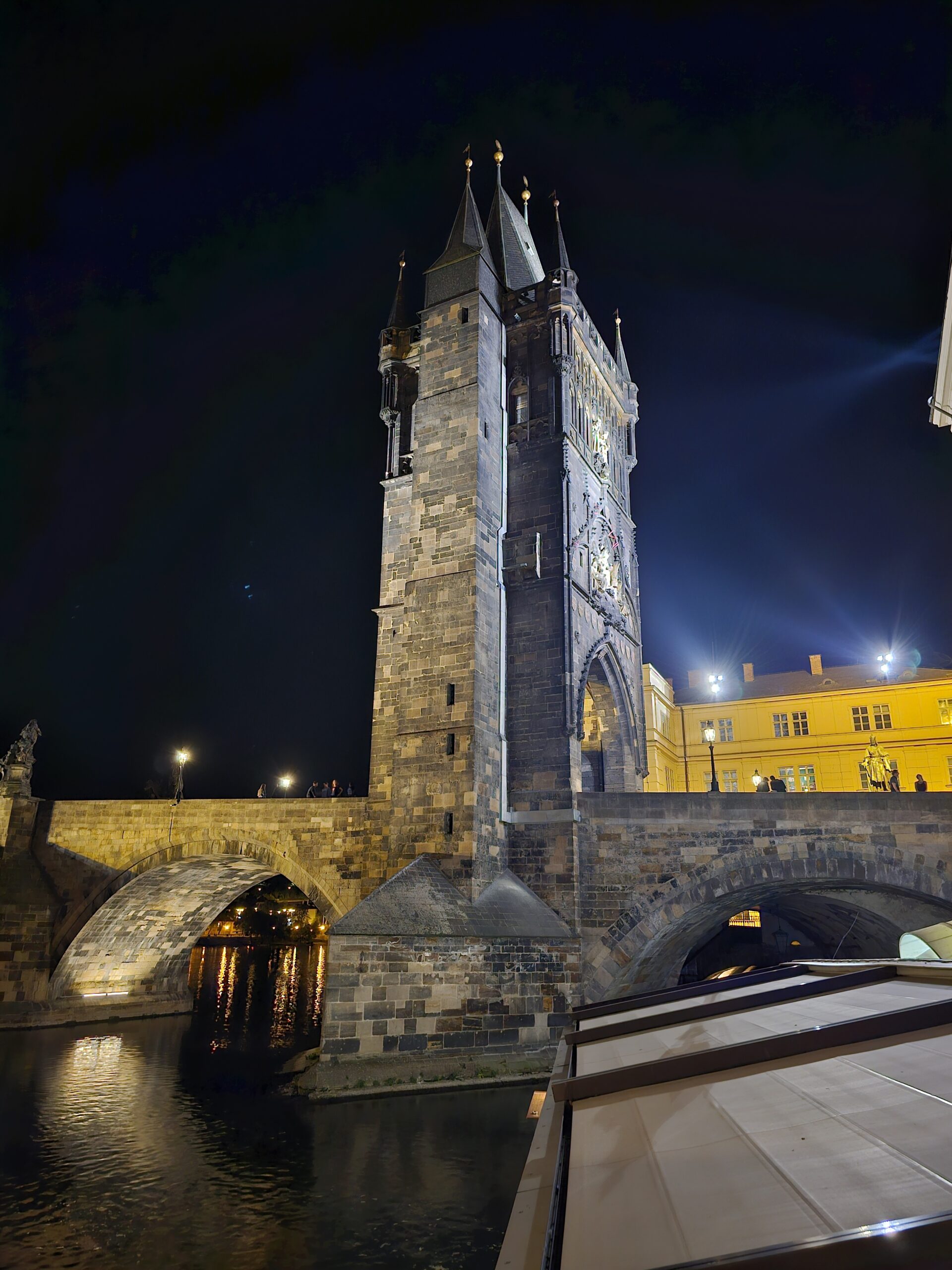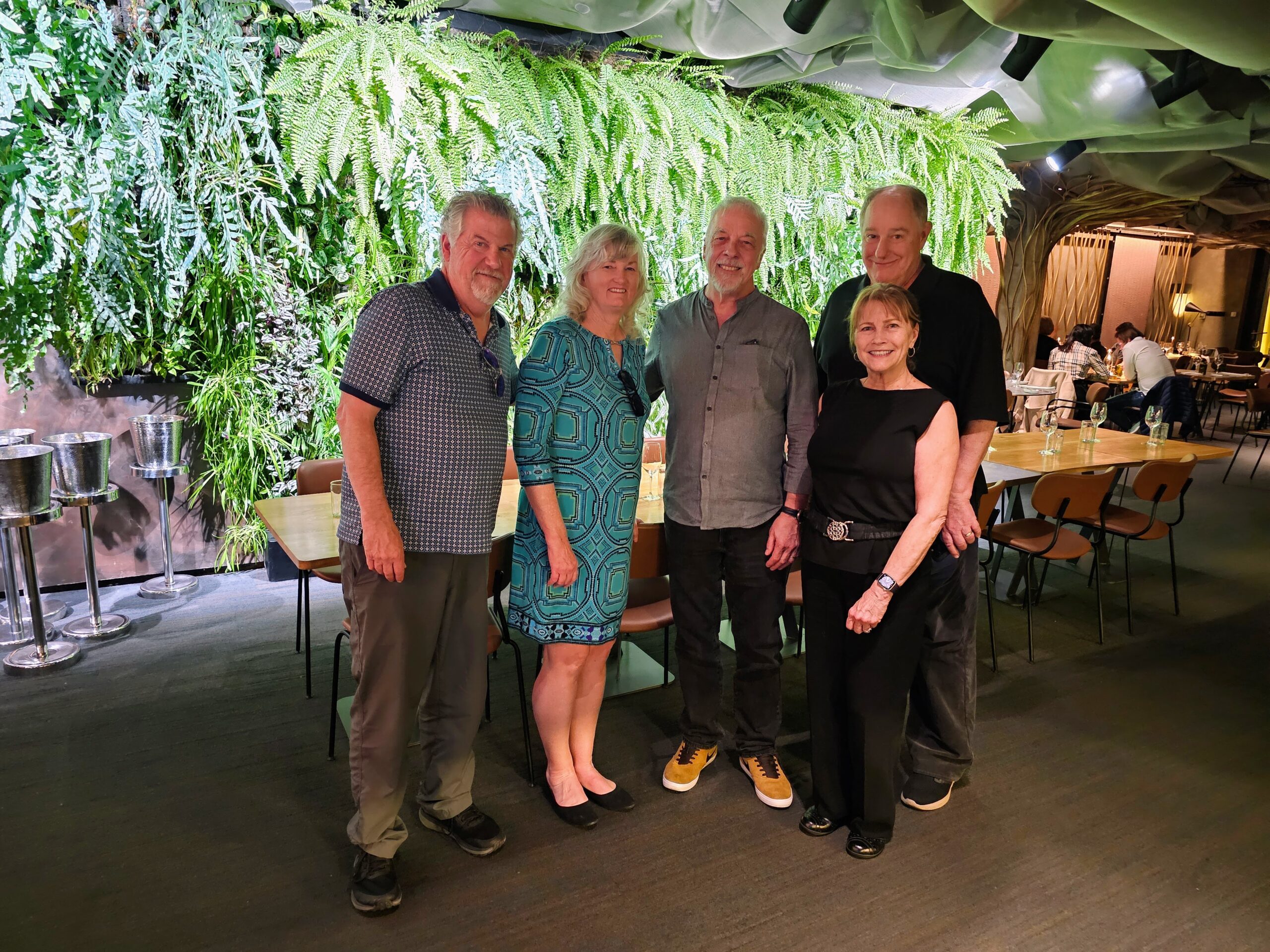We enjoyed our guide, Dagmar, on our first day so we hired her as our guide again, where we actually went inside Prague Castle and Saint Vitus Cathedral. Once again, she snagged tram passes and we made our way to the Castle. To be honest, don’t skip the tours, as the interiors are what makes this place really stand out.
Inside the cathedral, our guide pointed out this stained glass window, only it’s not stained glass, it’s paint. This window was created in 1930 by a Czech artist named Alphonse Mucha, and depicts the young Saint Wenceslaus with his grandmother Saint Ludmila, as well as small vignettes of the lives of Saints Cyril and Methodius who spread Christianity among the Slavs. We just liked the use of blues and greens!
Our guide then pointed out this room, the Chapel of Saint Wenceslaus, which houses the relics of the saint (that’s his tomb on the right). The chapel was built in 1356, and has 1300 semi-precious stones and paintings depicting the Passion of the Christ, all original, from 1372-1373.
The Chapel has this door that leads to the Crown Chamber which contains the Czech crown jewels (no, not the body parts, these are actual jewels). There are 7 locks on this door which are held by 7 different people, namely; President of the Republic, the Prime Minister, the Prague Archbishop, the Chairman of the House of Deputies, the Chairman of the Senate, the Dean of the Metropolitan Chapter of St. Vitus Cathedral and the Lord Mayor of Prague. They must all convene to facilitate opening of the impenetrable door and coffer.
Impenetrable?? Has anybody asked the Mission Impossible people about this? The jewels are only displayed to the public once every 5 years (some websites say 8, so your mileage may vary). I’d at least bring them out once a year, just so everybody knows Ocean’s 11, part 3, hasn’t happened!
Adjacent to the altar is this luxury sky-box for the Royals. They could sit up here and avoid the commoners, which was likely a good thing, since deodorant didn’t exist back then. They even had their own entrance from the castle!
There are numerous tombs in the cathedral, but the most impressive one is that of Saint John of Nepomuk, the guy who King Wenceslaus killed for not divulging his wife’s confessions to him. Two tons of pure silver were used to create this tomb!
The cathedral has this wooden panel that depicts Prague back in 1630. Our guide pointed out that was before any of the statues ended up on the Charles Bridge.
I love the shaft of light coming through the window right above the altar.
Here is a shot from further back in the cathedral. We were lucky to have a sunny day, as it really makes for a dramatic effect!
Towards the exit of the Cathedral I saw these glowing lights on the walls. Are they playing Pink Floyd over there?
The sun was creating a light show for us! Sadly no Pink Floyd. 😞
This window depicts Saint Ludmila (King Wenceslaus’ grandmother) as well as the Twelve Apostles. I just liked the resulting lighting spectacle! Quick hint, if you ever hear a European guide mention the “twelve apple-sauces”, they mean Apostles. They seem to say “apple-sauces” every single time! I kept thinking “do we even have any cinnamon?”
We then crossed the castle courtyard and entered the “Old Royal Palace” which dates back to the 9th and 10th centuries! The area below is called Vladislav Hall, and was originally used for horses and jousting ceremonies. The area where the wooden boards are was depressed and filled with dirt for the horses. That had to be quite the spectacle inside the palace!
Our guide than dragged us through a very crowded corridor, and I was curious what could be so important to run that gauntlet, when she showed us these windows, known as the “Defenestration Windows”.
Back in 1618, after the Holy Roman Emperor King Ferdinand II ordered the cessation of Protestant church construction on royal lands, a group of Protestants demanded answers from two Catholic regents. After accusations flew around, the two Catholic hard-liners and their secretary admitted they were the reason for the Emperor’s decision. The Protestants ended up throwing them from these 3rd story windows, presumably to their death. The Catholics survived after falling into a dung heap…which is where we get the saying “Shit Happens”. This act sparked what is known today as the “30 Years War”.
We entered a room that had a replica of the Crown of Saint Wenceslaus, the Royal Crown of the Czech Republic. At least we didn’t have to wait 5 (or 8) years to see it!
This area is known as the “New” Office of Land Rolls. This office held a record of who owned what for the entire country, and it actually burned down in 1541, hence the name “New Office”. On the walls and ceilings are the coats of arms for each position in the court structure.
This is a representation of what the land records looked like dating back to post 1541.
Here we are exiting the Royal area. The path we are walking down is called the “Rider’s Staircase”, and is specifically designed for horses to get into the castle to gain access to Vladislav Hall.
Our next stop was Saint George’s Basilica, the oldest surviving church building in Prague Castle. It was founded in 920, and reconstructed over the years, particularly after a fire in 1142. It’s a mere blip in size compared to Saint Vitus Cathedral! The walls are very thick and the windows very small, simply because they didn’t have the technology to build a church differently back in 920.
Our last stop within Prague Castle was a region known as the “Golden Lane”. This is the most famous street in Prague, and lies completely within the walls of the castle. Here is a look down the very narrow street.
It was also called Alchemist’s Lane or Goldmaker’s Lane, as this 16th century street was inhabited by alchemists supported by Emperor Rudolf II, as they were trying to unravel the mystery of making artificial gold. Below is the home of an alchemist, with pieces supposedly dating back to the time of his living here.
I guess back in those days you slept where you worked! The houses in this street were very small, basically like today’s tiny houses.
Down in the basement of this house is where the real work took place, but I’m guessing they never found the key to making fake gold. I think the Czech Republic would be a far different place today had they figured it out!
This is the interior of a very small pub. An inventory of houses and taverns in Prague in 1653 indicated that one in every seven homes included a tavern! That’s my kind of city!
The quote on the pub wall reads “better to put the axe in the block than kneel under the axe of executioner”. In a 17th Century pub this would be seen as a warning of the fate that awaited anybody who took up arms against the Catholic king.
One last stop on the Golden Lane was the torture chamber. It was so crowded I didn’t bother going down and inside. What a zoo! I can’t imagine coming here in the summer!
This is where our guide left us. We took one last shot from the edge of the castle walls, as they views are so nice up here, and the weather was perfect!
Kim and I needed some food and more importantly a pint of beer, and right across the street from our hotel is an Irish pub, so we had to stop for a Guinness!
I know, another long post…hang in there, almost done!
We relaxed for awhile and then decided to head up to Petrin Tower for an overlook of the city. We waited awhile for the funicular and then made the short walk to the tower. Built in 1891, it’s supposed to resemble the Eiffel Tower. Maybe the one in Vegas??
Regardless of the alleged comparison, there are excellent views from the top of the tower! This is looking towards Prague Castle.
This shot is looking just to the right of the castle, towards our hotel and the northern reaches of the Vltava River.
While this is the view towards the Charles Bridge. Look at how crowded that bridge is! It’s crazy!
Here is a shot from the funicular on the way back down.
Ok, two more photos then you are done! We ate at an excellent restaurant, one of the best of the trip, called Mylnec. The view of the Old Town Bridge Tower from the restaurant is excellent! The food was just as good…book this place!
We met musician and all-around nice guy John Fresk the night prior at the Italian restaurant next door to our hotel. He was so nice that we invited him to dinner the next night. John is an ex-pat from Oregon married to a Czech woman, and he is a professional jazz pianist. It was very cool to meet him and chat him up over dinner. I only wish we could have seen him perform before we had to depart.
Up next, we take a day trip to Kuntna Hora, a nearby city with a remarkable bone church. Until then, thanks for reading!

